10 Days in Portugal: A Perfect Itinerary for First Timers
Portugal holds a special place in our hearts because, in many ways, the Wheatless Wanderlust that exists today was born in 2021 after our three month European extravaganza.
That trip was the culmination of several years of plotting and saving leading up to our decision to quit our corporate jobs and bet it all on this website.
Unfortunately for us, we quit our jobs in February of 2020 and originally planned a version of that European trip for March of 2020. And you can probably guess what happened next (OOPS).
In the fall of 2021, we finally made that trip happen, and it was magical. It was bookended by a couple of weeks in Portugal on either end, and Portugal ended up exceeding all possible expectations that we had.
Even five or ten years ago, when we first set foot in Portugal (and were immediately scammed by a taxi driver in Lisbon – can’t win ‘em all), it would have been relatively difficult to find good information on visiting Portugal when compared to nearby countries in Europe like Spain, France, or Italy.
Fast forward to today and you’ll find Portugal has been all over many “10 new destinations to visit” lists that have been put out over the past decade.
At this point, nearly everyone in our group of friends and family has gone to Portugal, and nearly every single one of them has absolutely adored their time there.
We’ve sent MULTIPLE groups of friends and family on some version of this itinerary, and I returned to Portugal this spring to take the temperature and see how things had changed.
While there were certainly changes over that five year period – more tourists, particularly Americans, being front and center – I was pleasantly surprised to find that, by and large, things were fairly similar.
In this guide, here’s what we’re going to cover:
- Exactly how to plan out your trip to Portugal, including what stops to make, what route to take, and all the important logistics you need to know
- A guide to what to do, where to stay, and how to get there for each stop on the itinerary
- Options for shorter and longer trips if you have more or less time in Portugal
Throughout the guide, we’ll share our favorite finds and experiences in Portugal based on our multiple trips (spanning roughly a month around the country) to help you plan your unforgettable trip.
Sound good to you? Let’s get into it.
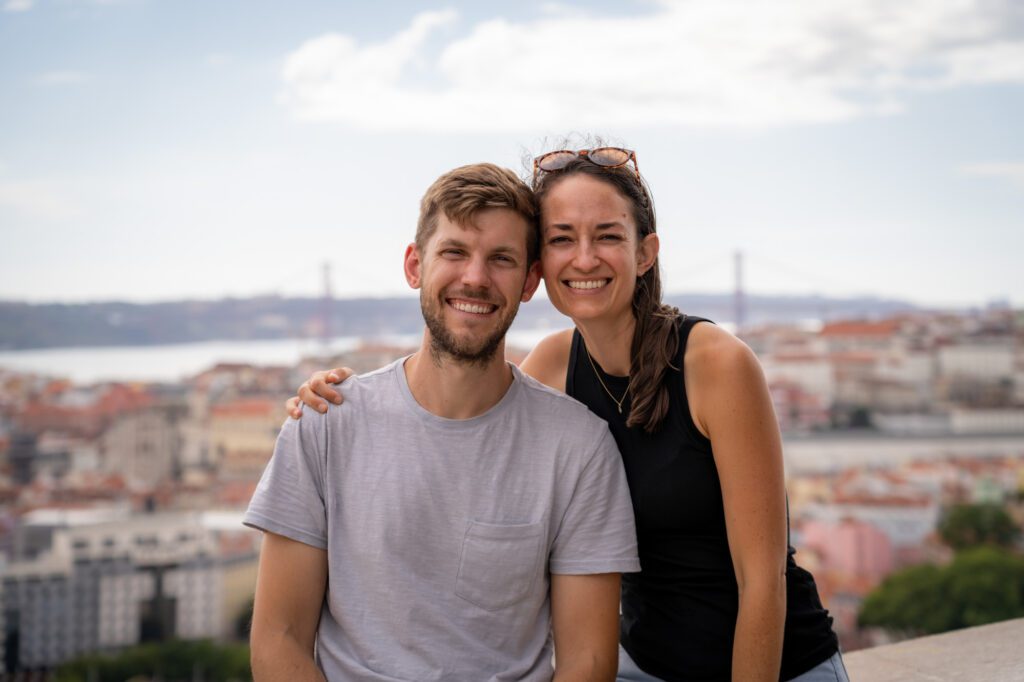
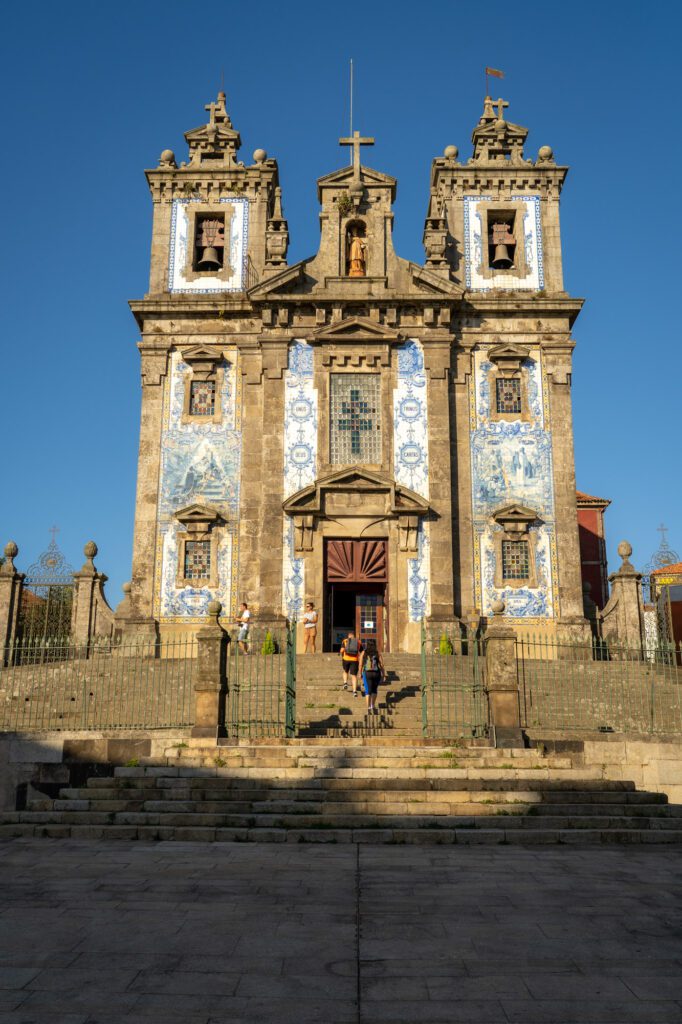

Disclaimer: Some of the links in this post, like hotel links, are affiliate links, meaning at no additional cost to you, we make a little bit of money if you click through and book. That being said, we would never recommend something to you that we don’t stand behind 100%.
How Much Can You See with 10 Days?
Obviously, you’re not going to be able to cover the entire country with just 10 days, so the question becomes what is the best way to spend your time to maximize what you can see.
10 days is a great start to exploring Portugal, but you’re going to have to pick and choose what to focus on.
At a high level, we think there are three regions that you should visit with limited time, and we think you should split your time roughly evenly between them.
Those regions are Lisbon, Porto, and the Algarve.
We’d urge you to resist the temptation to continuously add places to your itinerary until you’re scooting around Portugal like a madman (or madwoman), changing cities every day and sprinting between museums.
We’ve been there. Trust us.
We completely understand the temptation, have fallen victim to it many times, and are here to tell you that your trip will be much more relaxing, rewarding, and memorable if you spend more time in fewer places.
10 days is enough time to see some of the main highlights (like Lisbon and the Douro Valley), connect with locals and see their cities and regions through a different lens, learn about the unique history in Portugal, eat some great food and drink some excellent wine, and get a taste for what makes Portugal special (and to populate your list for places you want to go on your return trip).
But Matt and Alysha, what about Coimbra / Nazare / Braga (insert many other Portuguese cities here)?
Yes, all of those are well worth seeing, but if you only have ten days and it’s your first time, we’d recommend focusing your time on the three places we outlined above – Lisbon, Porto, and the Algarve.
What if you have more or less than 10 days?
- With 7 days we think you can realistically tackle the Lisbon – Porto corridor (including some nice day trips) OR the Algarve. Not both. Here’s our 7 day Portugal itinerary, which covers the Lisbon to Porto corridor.
- With two weeks in Portugal, you’ll have more time to breathe and can add a few additional stops in smaller cities like Braga, Coimbra, Tavira, or Évora in addition to seeing Lisbon, Porto, and the Algarve.
We’ll cover what to do with more or less time in Portugal in separate sections below the main itinerary.
How to Structure Your Itinerary
As we’ve traveled more and more over the past several years, we’ve come to realize that we have a strong perspective on how to approach a longer trip (10+ days).
The first thing we want to say here is that you should dedicate at least 2-3 days to each of Portugal’s big cities, Lisbon and Porto.
Trying to do either of those cities in a day is going to be mayhem, and you will inevitably be checked out and ready for a nap in the early afternoon as you’re heading to your next attraction.
We also believe that it is almost always better to choose a home base for a longer period and do day trips from there rather than moving around every day or two.
In this case, with 10 days in Portugal, we’d pick a maximum of three cities (or regions, like the Algarve) you want to use as a home base, and divide your time roughly equally between them.
As we already covered above, for your first trip to Portugal, we think those three places should be Lisbon, Porto, and the Algarve.
Those three areas are great places to visit in their own right from a culture, history, and food perspective, but they also offer some nice day trip options that will allow you to see other parts of Portugal without packing up and moving around every other day.
Where to Start and End Your Trip to Portugal
As we reworked this itinerary following Matt’s most recent trip to Portugal, we decided that there is really only one version of this trip that we’d want to do ourselves, and that is a trip that starts in Porto and works its way south, stopping in Lisbon and then the Algarve.
The alternative – flying in and out of Lisbon – means an awful lot of backtracking (which means lost time on an already limited amount of time).
That option means you’ll be booking an open-jaw flight – a flight that arrives in one city and departs from another – that arrives in Porto at Francisco Sá Carneiro Airport (OPO) and departs from Faro’s Faro – Gago Coutinho International Airport (FAO).
The other option is flying in and out of Lisbon’s Humberto Delgado Airport (LIS), which tends to have the most routes, particularly direct flights, in and out of Portugal to international destinations.
This is also likely to be the cheapest option, though it’s the least convenient in terms of logistics because it involves you making your way back to Lisbon from the Algarve, which can be a bit of a journey at over four hours.
Getting Around Once You’re in Portugal
Getting around Portugal with limited time is a bit complicated, which we’ll get into in a second.
At a high level, there’s a robust train network run by Comboios de Portugal and bus network through companies like FlixBus and ALSA that connect most major cities and towns throughout the country.
We love traveling by train, and it’s the best way to get around on the west coast, between Lisbon and Porto (and even further north than Porto) where there are both regional and high speed trains to choose from.
It’s also the best way to get from Lisbon to Faro, which will be your gateway to the Algarve.
Trains in Portugal are significantly cheaper than in places like Spain and Italy, which is an added bonus (they’re also slightly less comfortable, in our experience).
With limited time, always choose the high speed (Intercity, or IC) trains, which will be more expensive but significantly faster.
Once you get out of that major thoroughfare, the options for train travel get a little worse, which is where the bus network comes in.
Oftentimes the buses take roughly the same amount of time as the regional trains, and can be even cheaper.
For each step in this itinerary, we’re going to give you our take on the best way to get from one place to another. Oftentimes it will be the train, but sometimes the buses offer a convenient alternative.
We used Omio a lot on our trip to Portugal.
Omio shows you all the options for getting from one city to another in one place – by train, bus, or plane – so that you can compare without going to multiple other websites.
Plus, we ran into issues occasionally with our American credit cards getting declined through the official train website, and Omio was much easier to use without throwing our phones across the room.
It’ll cost you a very small service fee (usually one Euro per ticket), but we think it was a much, much better experience (which is why we used it so often).
How to Plan an Incredible 10 Day Portugal Itinerary
Here’s what the itinerary you’re going to find below looks like written out.
- Day 0: Arrive in Porto
- Day 1: Porto
- Day 2: Porto
- Day 3: Day Trip to Douro Valley
- Day 4: Travel to Lisbon
- Day 5: Lisbon
- Day 6: Lisbon
- Day 7: Day Trip to Sintra
- Day 8: Travel to the Algarve
- Day 9: Algarve
- Day 10: Algarve
Obviously, you’ll have to massage this itinerary a little bit to make it work with your specific flights.
We’re assuming you have 10 full days in Portugal, not including the half days that would be dedicated to your arriving and departing flights.
Obviously, there is a LOT to see in Portugal, and we have plenty of ideas on how to make changes to this itinerary.
For example, you could spend the entire time in the Lisbon to Porto corridor, renting a car to see some of the smaller cities and towns between the two major Portuguese cities.
Or you could spend the entire time along the southern coast (the Algarve) soaking up the sun and hopping from beach to beach.
You’ll find some of our ideas in the “with more time” section below, which you can use to make changes to your itinerary based on your specific style and needs.
Days 1-3: Porto & the Douro Valley
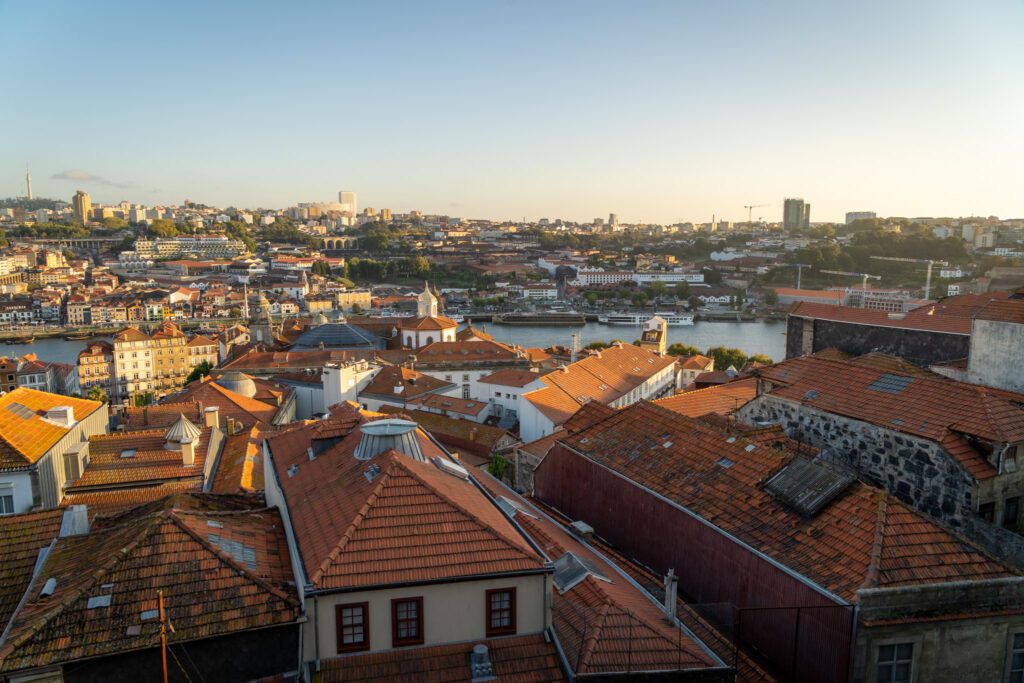
Your first stop in Portugal is Porto, which has a friendly rivalry with its neighbor to the south, Lisbon, over the fact that Porto was originally the kingdom’s most important city thanks to its port (see what they did there?).
Portugal was conquered by the Christian armies of the Inquisition from north to south, ending in the 12th Century, which is when the borders of present-day Portugal were formed (and have more or less stayed the same since).
We found Porto to be similar to Lisbon in some ways, but significantly different in many respects.
The first is that it’s a much older city. Lisbon was leveled by a massive earthquake (somewhere between 8.5 and 8.9 on the Richter scale) in 1755. Along with the subsequent fires and a tsunami. Not a great day for Lisbon.
Porto survived the earthquake, which means the buildings in the city center are much, much older. Which gives it a more lived-in feeling, and a less polished look.
We heard the word “gritty” used, but don’t quite agree with that assessment. Lived-in is a better term in our experience.
Everywhere you go in Porto, it feels like real people live there (rather than parts of Lisbon that feel like it’s exclusively tourists). And that’s a feeling that we really enjoy.
Porto is a great two day destination, which begs the question “why do you have us here for three days then?”
At the end of every trip, we do a “best experience / food / drinks” recap together over a glass of wine (or several). There was an experience that came up over and over again during the conversation about our trip to Italy, Spain, and Portugal.
And that experience was our day trip to the Douro Valley, which included a winery visit to try port, an amazing lunch experience, and a boat cruise on the picturesque Douro River.
It’s expensive, it’s true, but we think it’s worth a whole day of your time to see the famous terraced vineyards of the Douro Valley, one of the oldest wine regions in Europe (if not THE oldest).
Pro-tip: Every single local we met in Porto said something along the lines of “hey, be careful with port” – it’s super easy to drink, it’s 20% alcohol, and it’s full of sugar so the hangovers are awful. You’ve been warned.
Arriving in Porto
There’s a handy metro line (the purple line) that goes to and from the Porto airport – Porto Francisco Sá Carneiro Airport (OPO) – in 30-40 minutes.
You can buy tickets at the entrance, and it will connect you with the other metro lines once you arrive in the city. More information here.
If you have a bigger group or lots of luggage, you can also take a taxi, which will cost around 30 Euros.
What to Do in Porto
Here are some things we enjoyed in Porto, in no particular order.
For more, head over to our guide to spending three days in Porto, which has a deeper dive on the city and putting a reasonable itinerary together.
A Walking Tour to Learn about Porto’s History
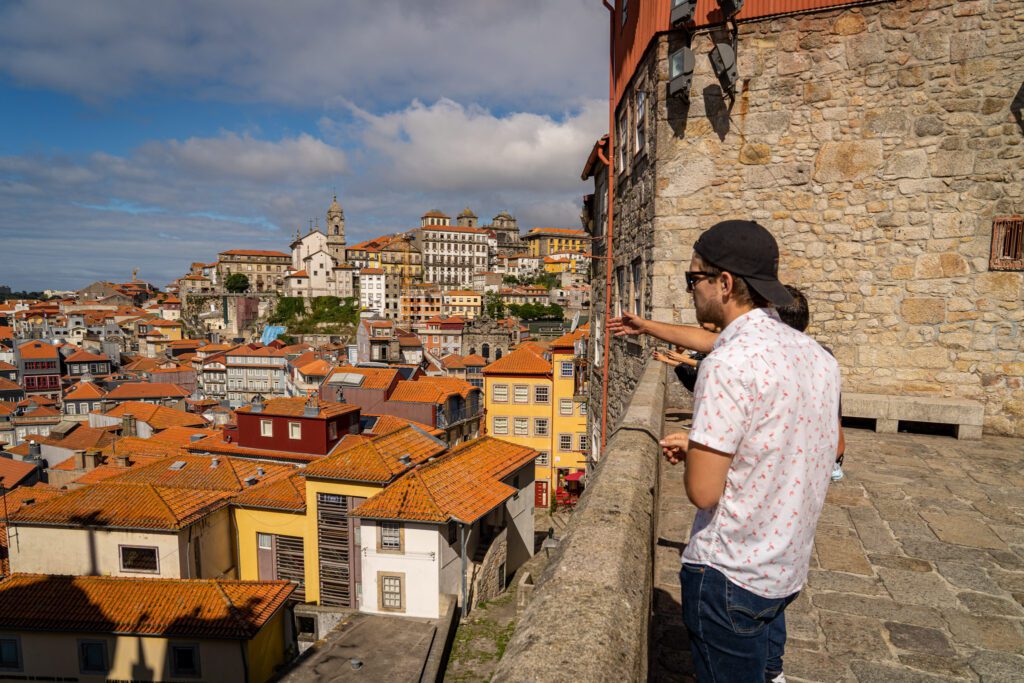
Porto’s history is fascinating, going all the way back to the Roman Empire (and beyond that, too) and along the way becoming the capital of Portugal before Lisbon was given that title.
One thing you’ll notice is the fact that Porto is an older city than Lisbon, mainly because of the earthquake that leveled Lisbon in 1755.
A walking tour will introduce you to all that history and more with a local who can give you tips on what to eat and where to eat it, how to get around, what not to miss, and more.
We always do walking tours in nearly every city we go to, and always walk away (ha!) with a bunch of new stories and a better understanding of history.
We’ve also learned that you get what you pay for here, and there’s a reason the free tours are, well, free.
Here’s the one we’d choose in Porto – Matt actually had that trip booked for his last trip before he decided to cancel the northern Portugal leg.
On our first trip to Porto, we chose this private walking tour in Porto ourselves with our favorite tour company, Withlocals (which only does private tours where you get to choose the guide based on your interests, which we love).
Visit All of the Miradouros
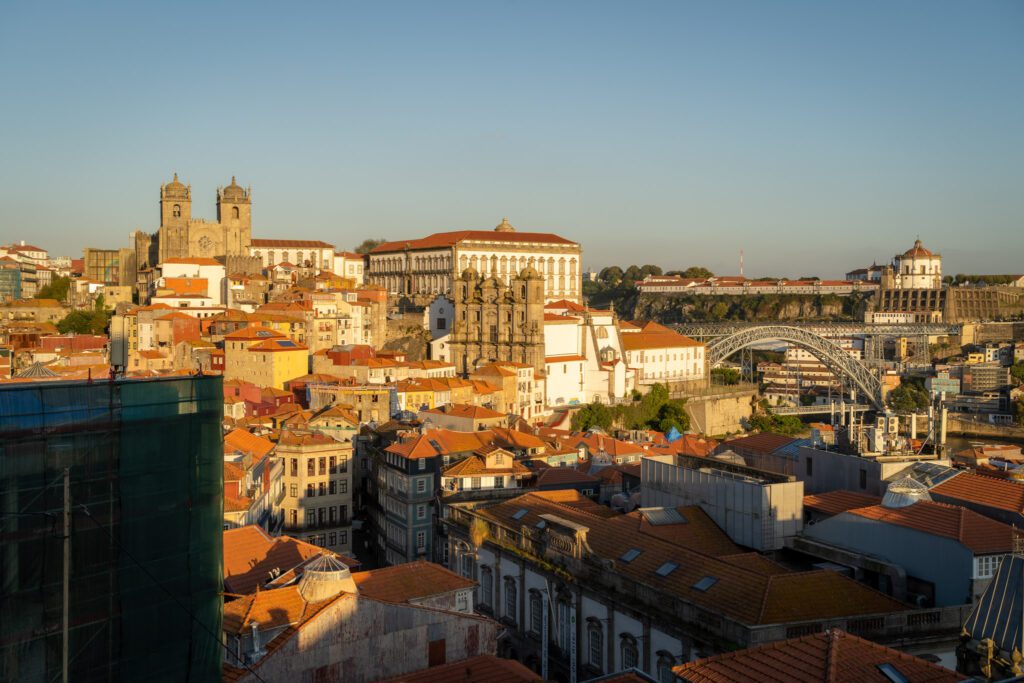
Porto is a beautiful city, perched on a hill overlooking the river below, so there are a few viewpoints that we think you shouldn’t miss.
First is Miradouro da Vitória (here on Google Maps), which is a place we found ourselves multiple times on our trip. It’s a great view out over the city and river, and it’s worth the effort you’ll expend coming from the bottom of the hill.
On the opposite side of the river, Jardim do Morro (here on Google Maps – technically in Vila Nova de Gaia) has some of the best views of the city, which sprawls up the hill away from the river, and the Ponte Dom Luis I (the bridge).
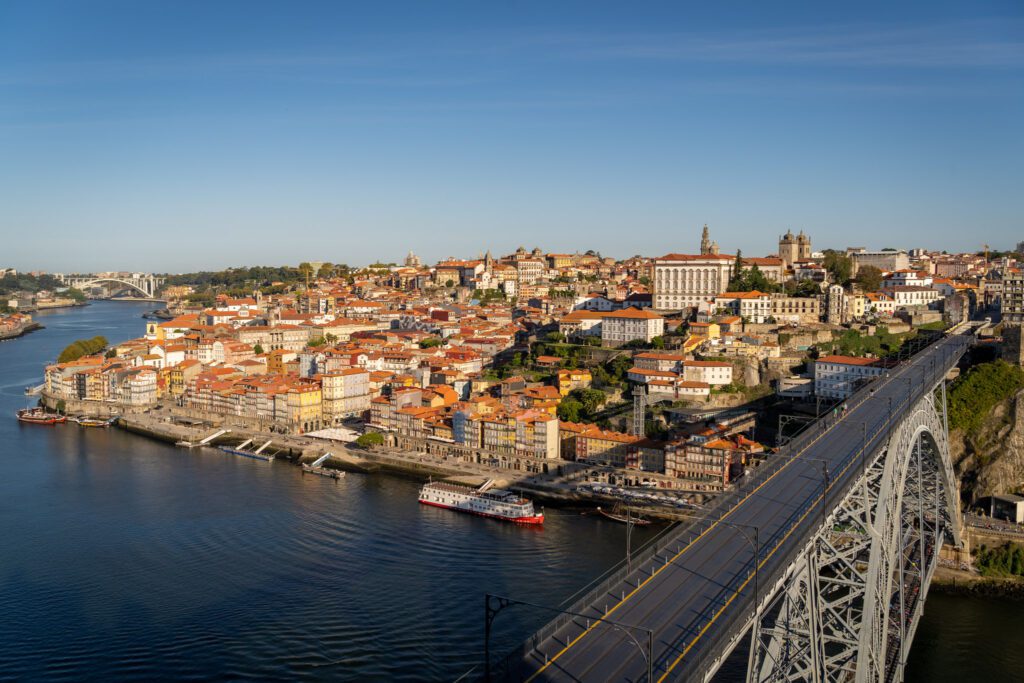
Learn About Port in Vila Nova de Gaia
Across the river from the city of Porto is a separate city called Vila Nova de Gaia, which is where all of the port houses are located.
It’s worth an afternoon of your time to cross the river and do a tour, where you’ll learn about the process of making port and usually get to enjoy a tasting at the end to understand the differences between ruby, tawny, and the other types of port.
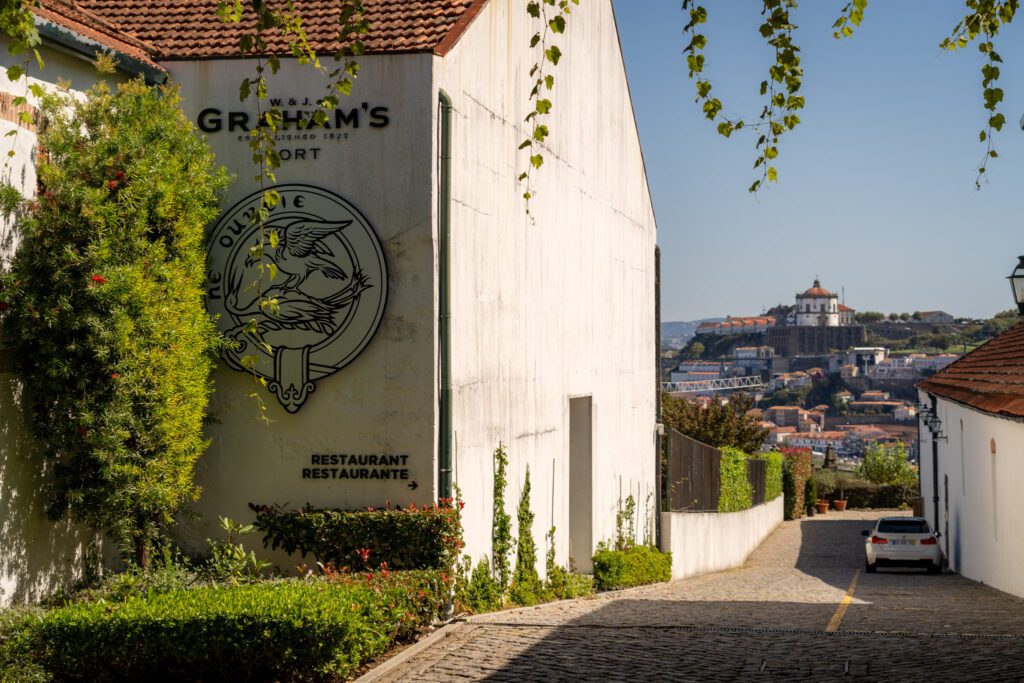

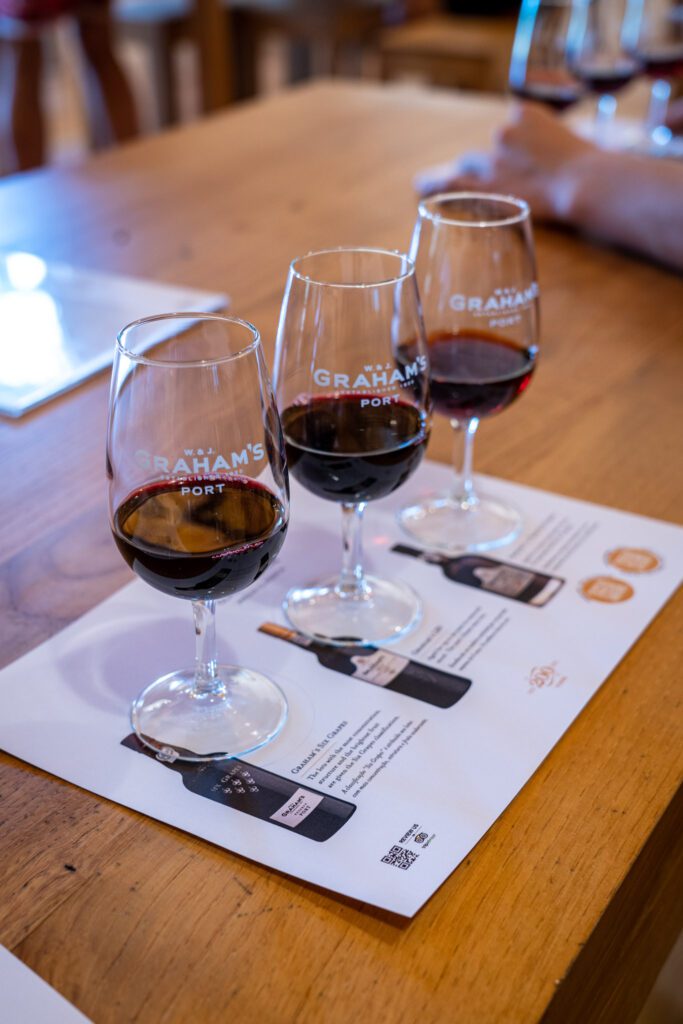
We did the tour at Graham’s Port Lodge and really enjoyed it, though we also heard good things about Taylor’s and Churchill too from various locals we interacted with.
If you’re looking to try port in the city center of Porto, go to Prova, where we got a mini-lesson on the basics of port before we made it across the river later in the trip.
You might notice that all of the port houses have very, uh, English names. Graham’s. Taylor’s. Sandeman’s.
That’s because they were, and still are, owned by English companies who, at the time they were started, were looking to find a new source of wine after the French ramped up prices.
Explore Porto’s Gorgeous Azulejos
Azulejos are the white and blue tiles that you’ll find adorning all sorts of buildings around Porto (mostly churches, really), and they’re one of the country’s more famous exports and probably one of the things you know about Portugal.
There are several places to check them out while you’re in the city (including the train station), but a few stand out to us.
- Capela das Almas: This small chapel is famous for its striking blue and white tiles painted with scenes from the lives of saints. The church has become one of Porto’s most photographed landmarks. You’ll find it here in Bolhão.
- Igreja de Santo Ildefonso: A baroque 18th-Century church at the top of a hill in Old Town with azulejo blue and white painted ceramic tiles. Find it here close to São Bento Train Station.
- Igreja dos Carmelitas & Igreja do Carmo: These two connected 16th-17th Century churches feature orate granite facades with beautiful tiled walls. The lavish Baroque and Rococo style interiors of Igreja do Carmo are worth visiting too. The two churches can be found here.
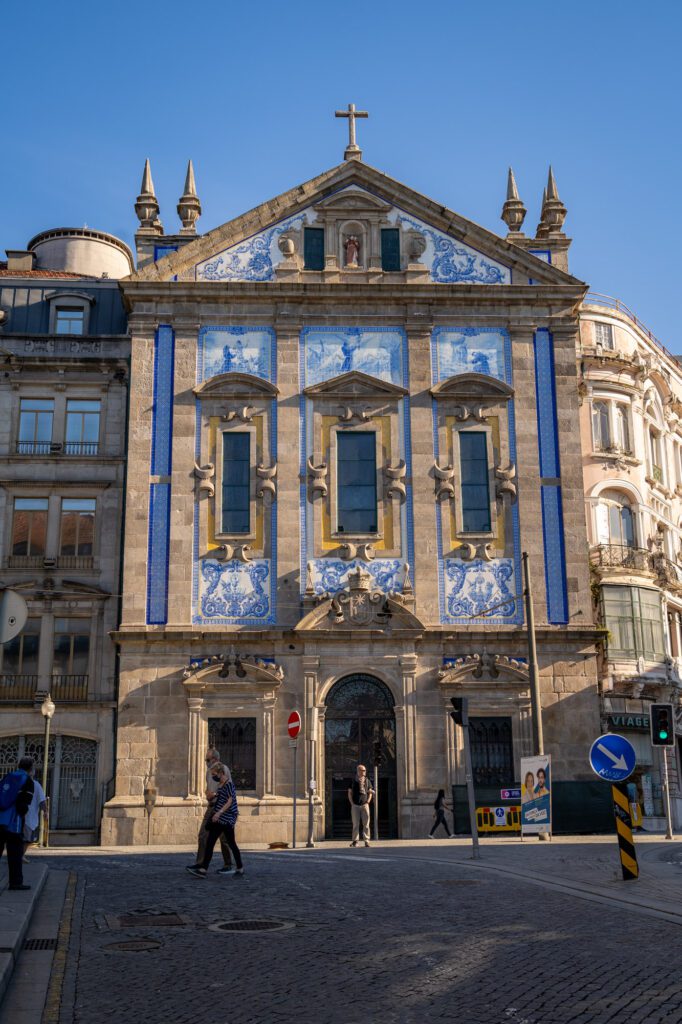

Eat a Bifana and a Francesinha
Two of Porto’s most famous dishes are meat-heavy sandwiches that we had mixed feelings on. Neither of us are huge meat eaters, and I have Celiac Disease and need to eat gluten free, so our choices were limited.
We did manage to find both, though!
The Francesinha is a sandwich stacked with multiple types of meat, a fried egg, and a spicy sauce made of beer and broth. It’s basically a heart attack on a plate. We enjoyed it, but probably wouldn’t eat it again.
The second is the Bifana, which is a pork sandwich that is both cheap and delicious.
My brother was the guinea pig here, and ended up enjoying it.
We got it at Conga, recommended to us by our walking tour guide. You know it’s authentic when you can see them making the meat in the window.


If you’re looking to get some deeper knowledge and insight into the food scene in Porto and northern Portugal, we’d recommend a food tour.
Given the fact that I have Celiac Disease, we didn’t do one ourselves (it would just be me salivating over everyone else eating delicious food, even though I’d love the history and stories part of the tour). Here’s the tour we would have done, had it made sense.
Livraria Lello
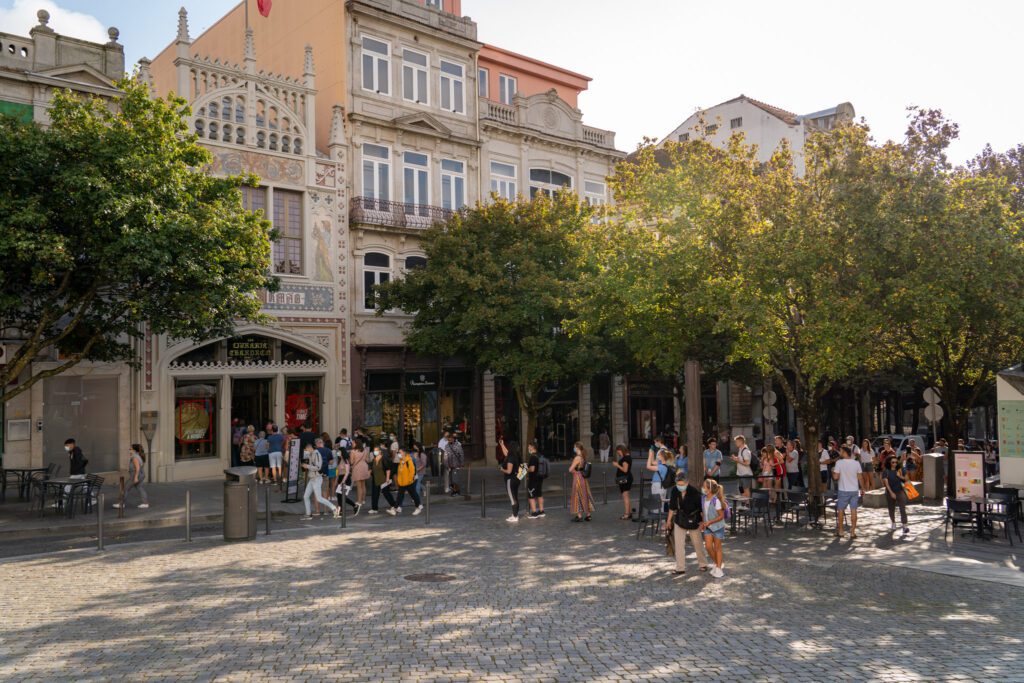
We’re conflicted about this one, because we actually chose to skip it after seeing the massive line outside – which exists all day long, opening to closing.
Livraria Lello is a beautiful bookstore that became famous when fans learned that J.K. Rowling wrote a portion of the books while working in Porto as an English teacher in the early 90’s, and that this bookstore might have served as inspiration (key word: might).
The interior, particularly the staircase, is beautiful, but we were a little shocked by the price and popularity.
It’s 10 Euros to enter (at the lowest), which you’ll get back if you decide to buy a book. You can buy tickets and find more information here.
Planning Your Day Trip to the Douro Valley
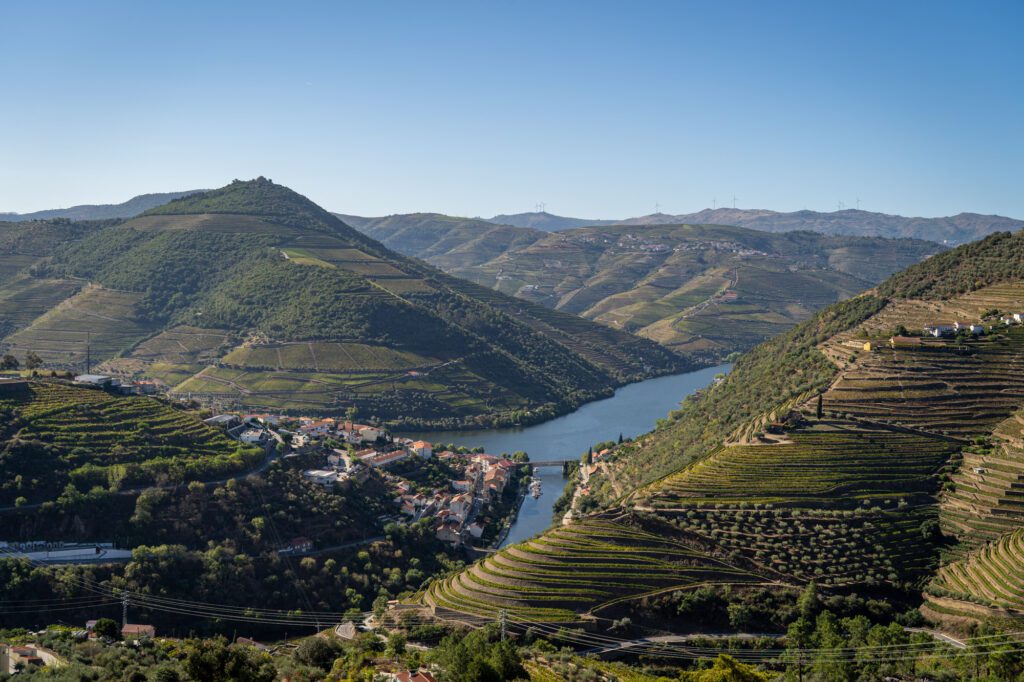
It’s not an exaggeration to say that our day trip out to the Douro Valley was the highlight of our three months we spent galavanting around Europe.
Between the unique terraced vineyards lining the steep hillsides of the valley and the winding Douro River, it’s one of the most beautiful wine regions we’ve ever been to.
We tell EVERYONE about it the second they say that they’re thinking about a trip to Portugal, because it is well worth setting aside a day for, even with a relatively limited time in Portugal.
Basically, you could do this as a self-guided day trip on your own, but that presents a couple of problems.
Either you have to rent a car (which is inconvenient and means you can’t enjoy the wine as fully), or you have to take the train (which means you’ll miss a bunch of the viewpoints and wineries that a car allows you to get to).
We considered it, but at the end of the day, we went with this full day tour, loved it, and have sent multiple friends and family members on the same exact tour since.
Here are the highlights:
- It includes pickup in central Porto, so you don’t have to worry about getting out there on your own (it’s a 1.5-2 hour journey by car or train).
- It includes multiple wine tastings – a guided port tasting, tons of wine with lunch, and a port tonic on the boat ride.
- It includes a HUGE lunch, complete with different non-port wines to try, in a tiny town where one of the owner’s parents grew up. I do mean huge – we thought the first course was the entire thing, and ended up being so full by the end.
- You get to hop on a boat ride on the Douro River to see the terraced vineyards of the Douro Valley from a different perspective than most people.
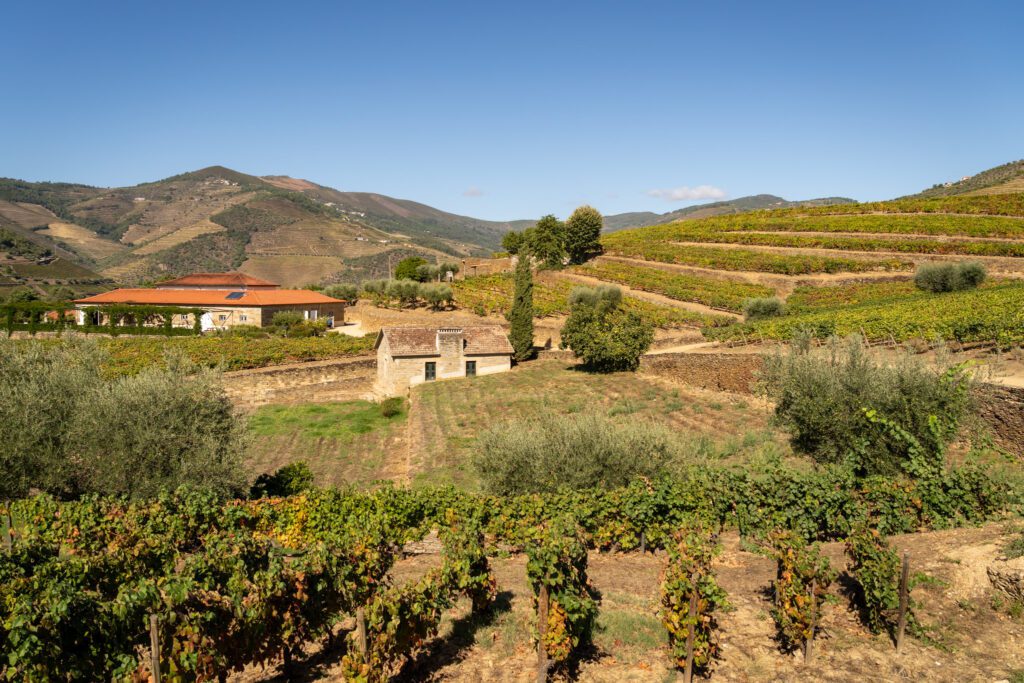
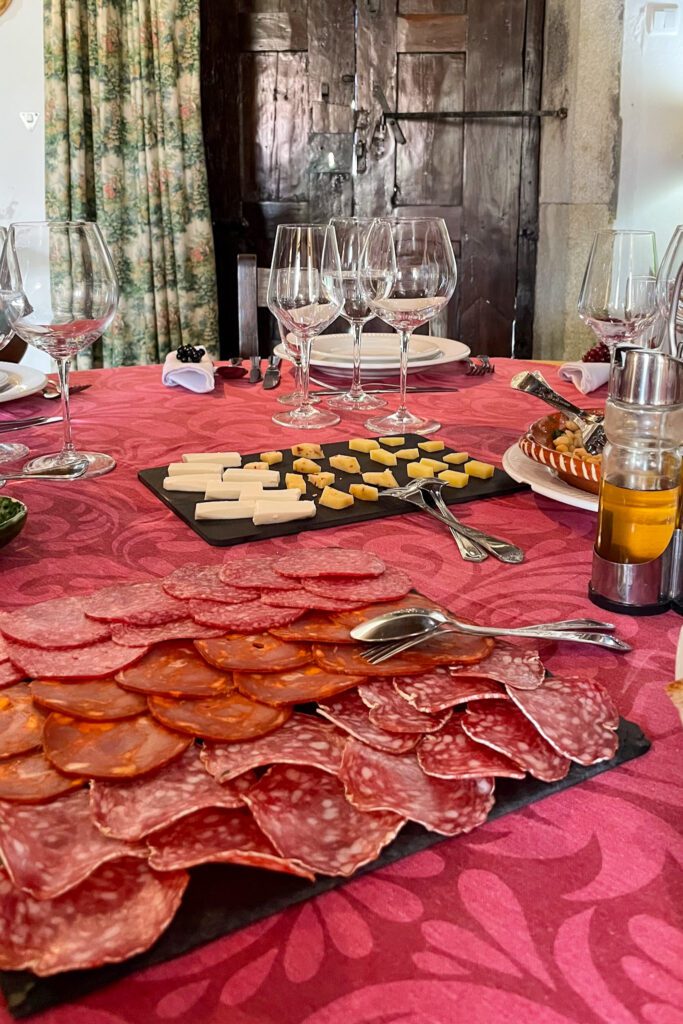
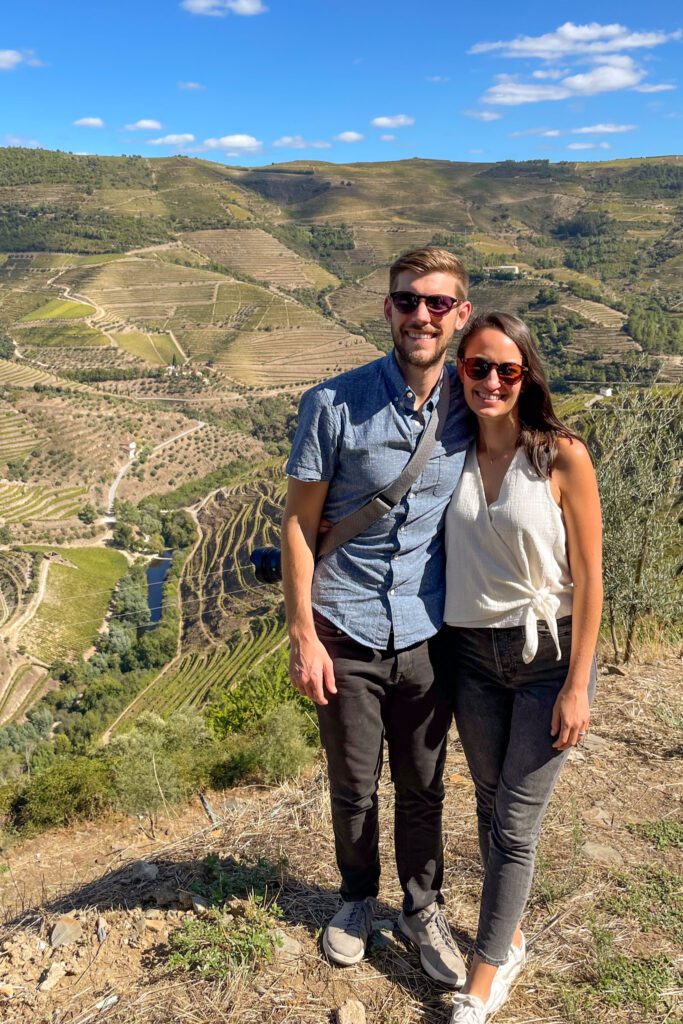
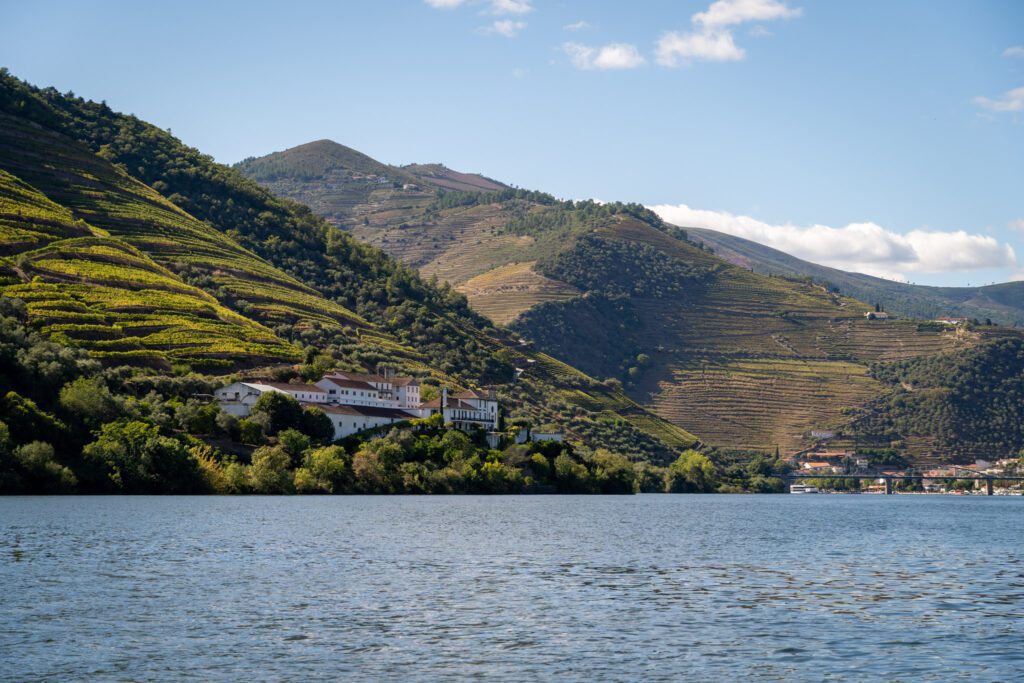
At the end of the day, it’s definitely not the cheapest way to see the Douro Valley, but we came away thinking it was a good value, and absolutely loved the experience from start to finish.
And we haven’t even mentioned the friendly guides who you’ll spend the day with!
They’ll give you some insight and commentary on life in Porto, give you recommendations on where to eat and drink in the city, and you’ll get to meet other like-minded travelers who are on the tour with you.
Click here to check prices and availability for your trip to the Douro Valley
Where to Stay in Porto
Porto is a compact city, so staying anywhere near the center of the city is going to put you within walking distance of basically everything in the city. It’s a little bit hilly, but not too bad.
We have an entire guide dedicated to deciding where to stay in Porto, which you should definitely read if you want to get deeper into each neighborhood we recommend and why we like it.
Otherwise, here are the highlights.
We’d recommend staying relatively close to the river, either in the upscale Ribeira neighborhood along the river, or in one of the neighborhoods adjacent to it to the north.
We personally stayed in Bolhão, which was about 10-15 minutes away from the river on foot, and was a more affordable location than the area along the river.
And, to be honest, it was much more enjoyable and we’d stay there again in a heartbeat.
We heard mostly Portuguese (versus the mix of English, French and Spanish you’ll hear near the river) and there were a ton of great places to eat and drink within 3-5 minutes of walking. And it felt younger and more lively, particularly at night.
We stayed at Your Opo Cozy Apartments, which was the perfect base for us because we need access to a kitchen and prefer having more space to spread out (especially since we were traveling with my little brother).
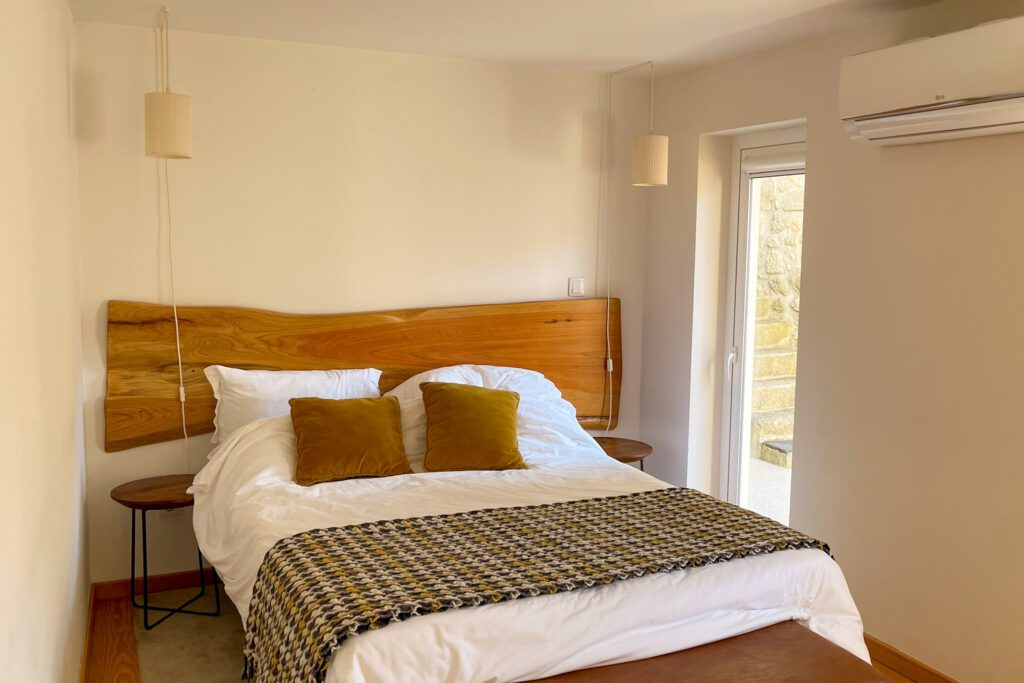
We also had our eye on Hotel Moon & Sun, which is a good option if you’re looking for a nice hotel in a great location (across from one of our favorite coffee shops in the city).
Update 2025: My mom and her friend stayed at Hotel Moon & Sun a couple of years ago and loved it. The location is great (they also loved So Coffee Roasters across the street).
We were originally going to stay at The Passenger Hostel, but changed to an apartment with more space when my brother decided to join our trip.
Days 4-6: Lisbon & A Day Trip to Sintra
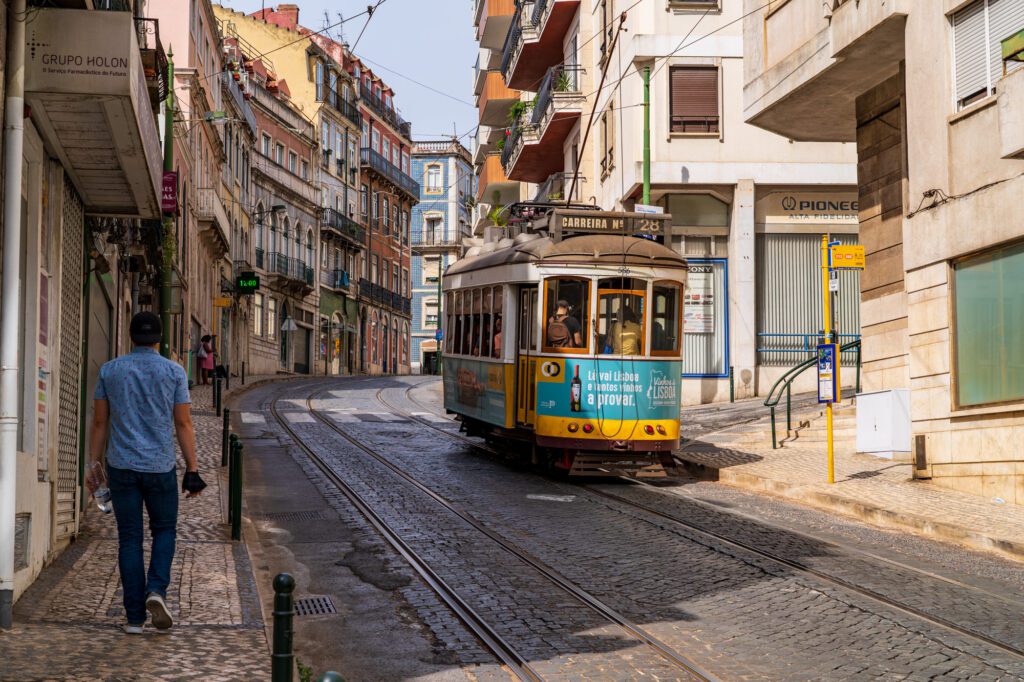
Lisbon, Portugal’s capital, was both our first stop in Portugal and was also our last stop in Europe a couple of months later when our 89 days in Europe were up (that’s just shy of the 90 day maximum we can spend in the E.U. on a tourist visa).
Matt has since been back for a week this spring to see how the city has changed with the incredible rise in tourists (especially Americans) over the past few years.
It’s still a beautiful city, especially when viewed from one of the many miradouros littered across the hills, but it has certainly started to see some of the problems that an influx of visitors bring to a city (higher cost of living, businesses catering to visitors rather than locals, etc).
We really enjoyed Lisbon, and spent the better part of a week wandering the streets of Lisbon’s neighborhoods on our first trip, stopping here and there for a cup of coffee or a glass of Portuguese wine – which is both cheap and delicious – the two best wine tasting notes, in our opinion.
Lisbon is a city not unlike San Francisco, our former home, in that each neighborhood has a distinct look, style, and overall vibe.
As you walk from the cosmopolitan grid that is Baixa, Lisbon’s downtown, towards the narrow, winding cobblestone streets in Alfama, the oldest-feeling part of the city, you’ll understand what we mean.
The areas are a few short blocks apart, but couldn’t look and feel more different.
Once you begin to understand the history of Lisbon, you’ll start to understand why. We’re obviously not Lisbon history experts, but we did a couple of walking tours and connected with locals who are.
Our Drunk History (if you’re not familiar, it’s a tv show where they film someone simultaneously telling a story about a historical event and getting wasted at the same time – it’s really fun!) take on the reason that Lisbon’s neighborhoods look and feel so different is that, after the earthquake in the 18th Century, the city brought in various architects from different places around the world to help rebuild and replan the city.
As a result, you have parts of the city that look like Paris, with grand boulevards lined with four story apartment buildings, and parts of the city that feel like Ancient Rome, with cobblestone streets and castles.
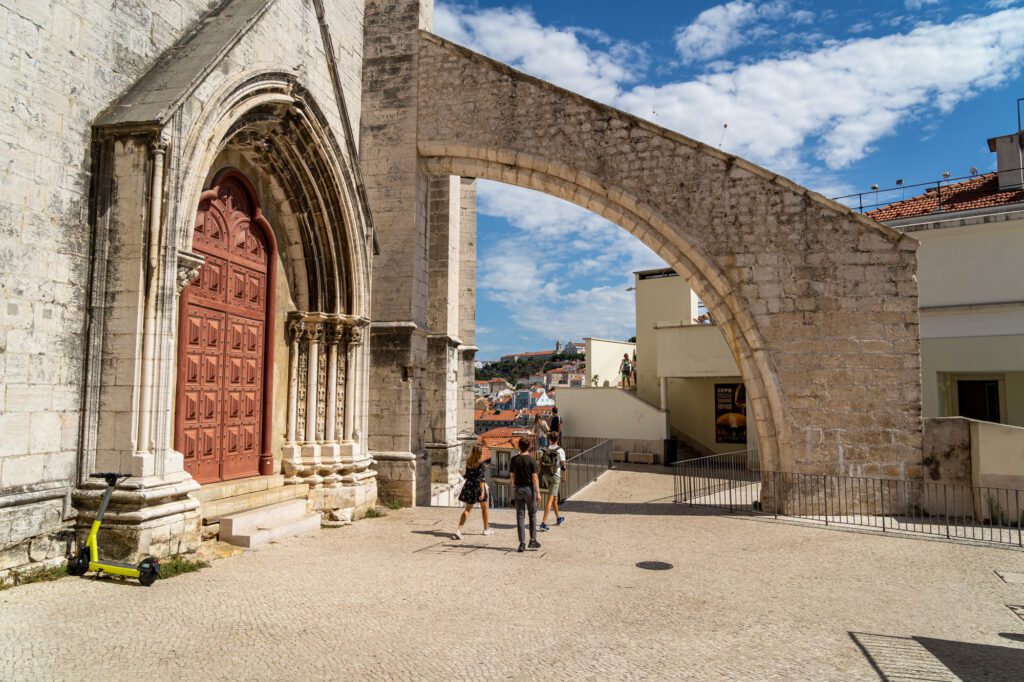
Getting from Porto to Lisbon
The journey from Porto to Lisbon is an easy one, with multiple trains departing throughout the day connecting Portugal’s two biggest cities.
Hourly Intercity (IC) trains – those are the fast ones – depart from Porto’s Campanhã train station and will take you to Lisbon in about three hours.
We’d opt for an early train to get to Lisbon by noon or so.
Plan to arrive at Lisbon’s Santa Apolonia station, which is connected to the rest of the city with Lisbon’s clean and efficient metro.
The alternative is Oriente, which is further out and not as well-connected.
Click here to see prices and train times for the journey from Porto to Lisbon.
What to Do in Lisbon
We have an entire guide to spending 3 days in Lisbon along with a guide to our favorite things to do in Lisbon, which you should definitely read for far more detailed information on exactly what to do and see in Lisbon.
Take an Introductory Walking Tour
We always start our time in a new city off with a walking tour, and Lisbon was no different.
It’s an excellent way to get a historical and cultural overview of the city, along with some useful tips you can use over the course of the next few days.
We had a group of three, so we did this private walking tour with WithLocals, which has quickly become one of our favorite tour companies.
You get to pick your guide and they’ll customize your tour based on your interests and their expertise.
We had a lovely afternoon with Isabella (who we’d recommend!) wandering from Chiado across the city to Alfama.
On my last trip to Lisbon, I was in search of a walking tour to do on my first day to get reacquainted with the city and ended up as the only participant on Humberto’s LisboaLove walk.
It’s a small group tour that focuses on the history of Lisbon and makes its way through Bairro Alto up on the hill, which is where Humberto grew up (it also means that you’re spending most of your time in a neighborhood that only a fraction of tourists ever make it to).
I really enjoyed it, and would recommend it as a nice introduction to Lisbon on your first day if you’re not looking for a private tour.
Explore Alfama
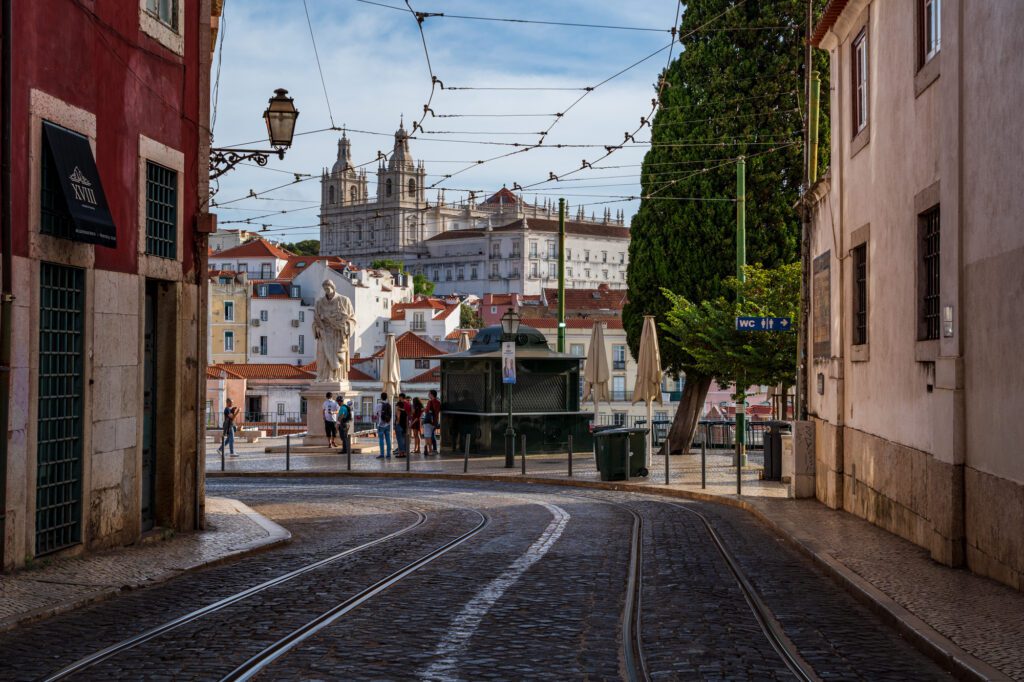
Alfama sits on one of Lisbon’s many hills, and is the oldest feeling part of the city, with a maze of narrow cobblestone streets sprawling down the hill from the Castelo de São Jorge, which sits at the top.
We like to start at the castle (which has nice views out over Lisbon) and make our way down to Baixa, winding through those narrow streets in the late afternoon.
Here’s a map of one version of that route.
Don’t miss a stop at Miss Can for some canned fish, one of our favorite discoveries in Portugal.
Soak in the Views
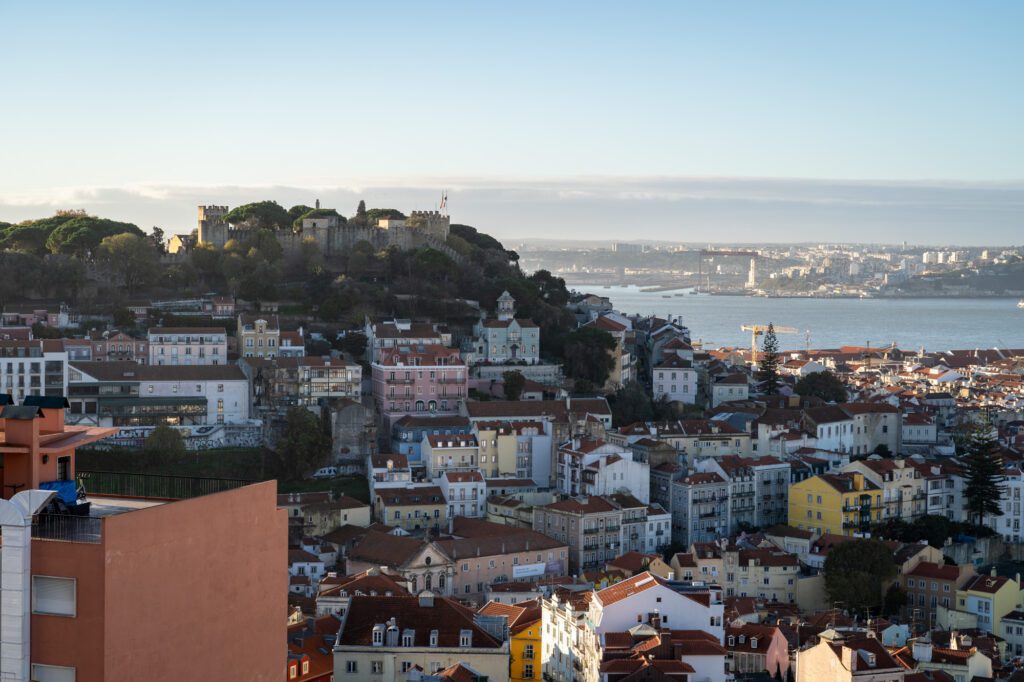
Kind of like San Francisco, which is where we lived and met over a decade ago, Lisbon is a city of hills. Which means there are incredible views to be had from atop said hills.
Sure, it’s usually going to take some effort – there were multiple points where we were sweating profusely in search of a great view – but once you’re at the top, the reward is worth the effort.
There are three viewpoints in Lisbon that stand out to us as worth prioritizing.
First is our favorite view of the city – Miradouro da Senhora do Monte (which you can find here on Google Maps).
This view includes the Castelo and hill that Alfama sits on along with the river in the distance and the oval-shaped Praça Martim Moniz in the foreground.
It’s a bit of a trek to get up there – and the public transit options are somewhat limited – but it’s well worth it.
There are a couple of things worth checking out nearby that involve beverages, namely the craft brewery a few blocks below (8a Graça – here on Google Maps) and Lapso Specialty Coffee Bar (here on Google Maps).
It’s also worth stopping by Miradouro da Graça (here on Google Maps) on the way up or down, though the view isn’t quite as nice as the one from further up the hill.
The second viewpoint is actually a couple of views within a couple of blocks in Alfama.
The two viewpoints are Miradouro de Santa Luzia (here on Google Maps), which looks southeast out over the river and the sprawl of Alfama down the hill, and Miradouro das Portas do Sol (here on Google Maps).
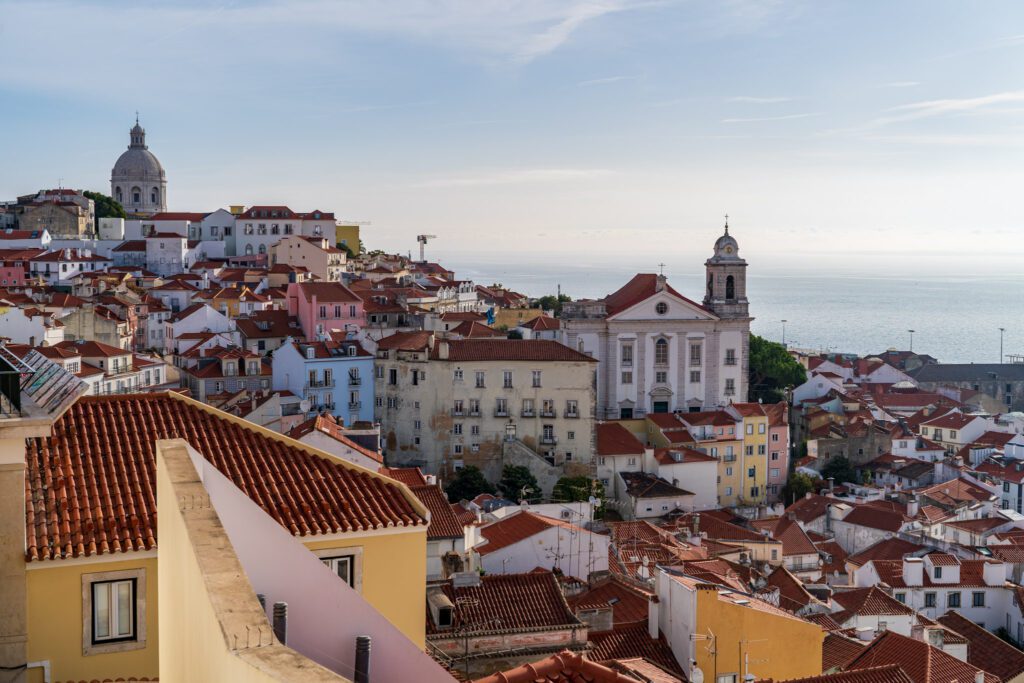
Again, there are a couple of spots worth stopping by right near these views.
We love Miss Can for their sustainable tinned fish (we bring back a bunch whenever we’re in Lisbon), and they have a restaurant right up the hill from Miradouro de Santa Luzia.
There’s also a great work of street art that depicts the history of Lisbon in a passageway under a set of stairs here on Google Maps that’s worth a quick stop.
And while the quality of drinks isn’t going to be perfect, we also think a stop at Quiosque das Portas do Sol (here on Google Maps) for a drink or coffee is worth the price for the view you get from the terrace.
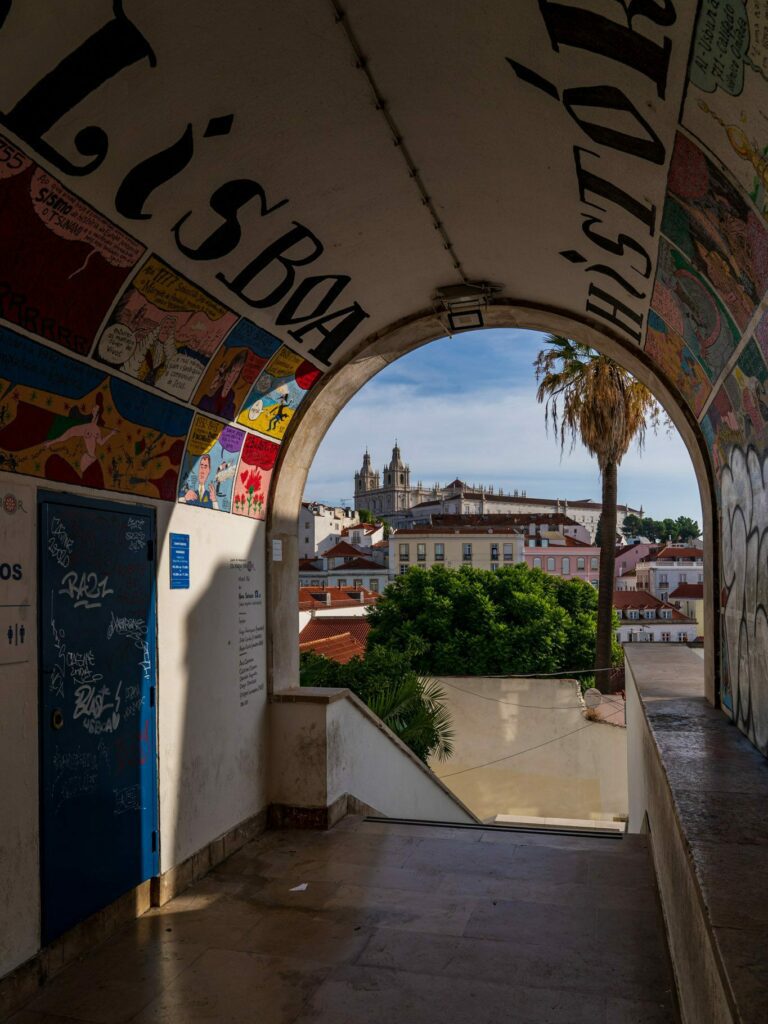
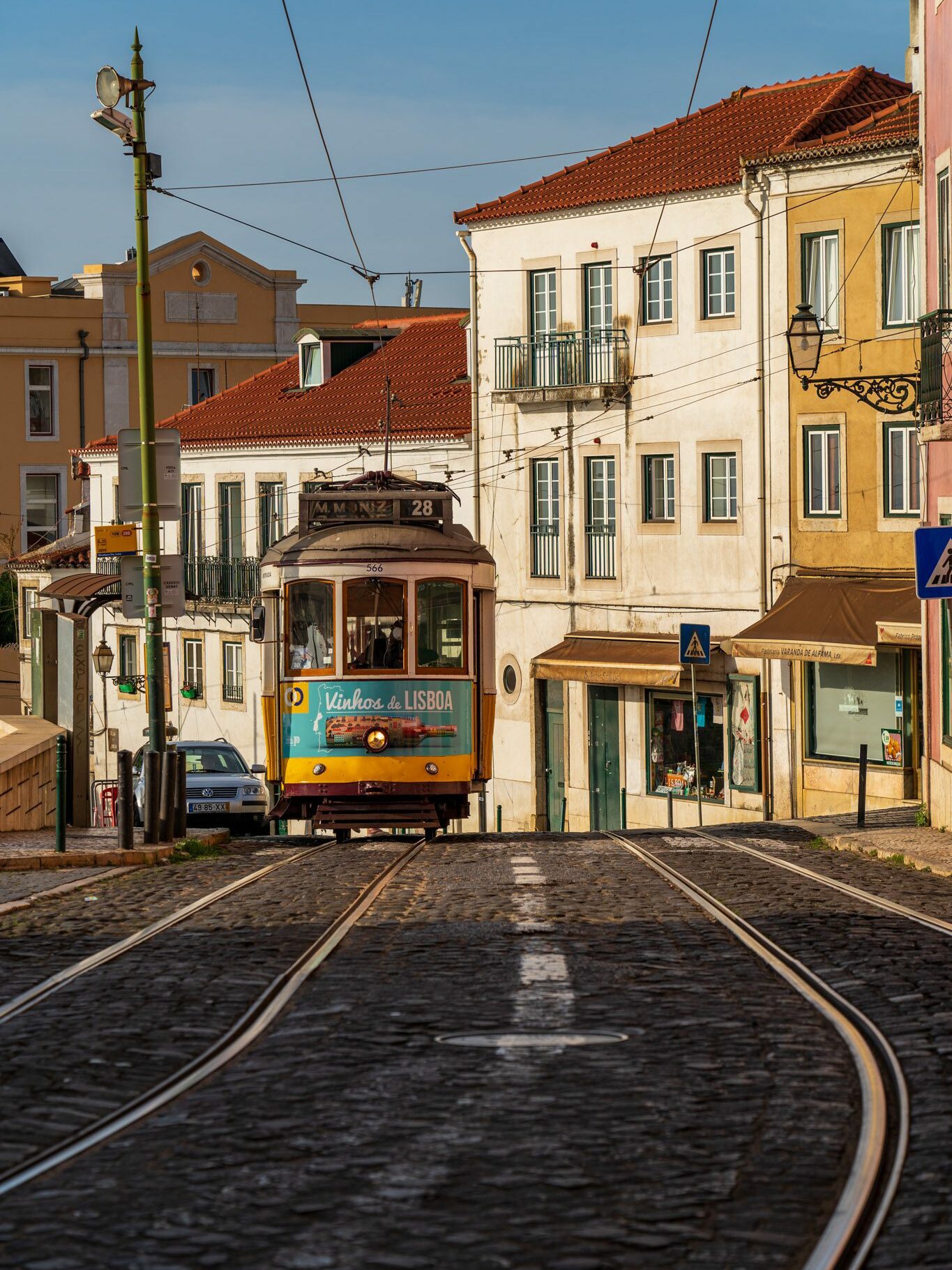
The last viewpoint we like is from across the valley from the other two at Miradouro de São Pedro de Alcântara (here on Google Maps).
Here you’ll find a great view that is more accessible from central Lisbon and also has a nice little guide to the various hills and landmarks you can see.
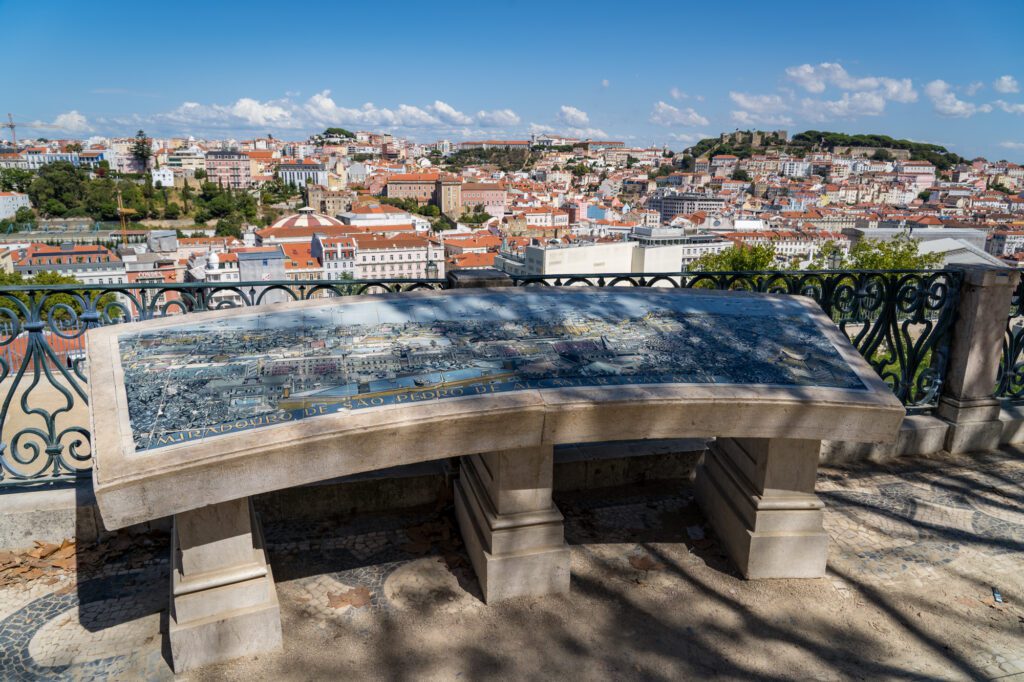
Dive Deeper into Lisbon’s Food Culture
Experiencing the food culture in places we’re visiting is one of our favorite aspects of traveling, and we try to include a food tour, cooking class, or market tour in most places we visit.
Unfortunately, the reality is that because Matt has Celiac Disease and can’t have even a speck of gluten without being sick for days, a food tour or cooking class wasn’t in the cards for us in Lisbon.
HOWEVER. That does NOT mean it shouldn’t be for you!
We’d highly recommend it because it gives you a local’s perspective on the city’s food scene – what and where to eat and drink – and you get to connect with fellow travelers and try some amazing food.
Here are some options for you, split between food tours and cooking classes.
Our preference is to do a cooking class, because we LOVE to cook and it’s generally easier to make work for Matt, but we also enjoy a good food tour.
When my mom and a friend went to Portugal a few years after us, they did this food tour in Lisbon and loved it (it was one of the tours that convinced my mom that it is sometimes worth splurging on guided tours).
It’s with Eating Europe, a company that operates tours across the continent.
Generally, we prefer finding local companies (versus bigger multinationals), and there are a couple of great options in Lisbon, like this food tour in Alfama or this food tour with 17 tastings, which would be our top two picks.
If you’d prefer a cooking class, we’d suggest either this class focused on pastéis de nata or this cooking class that focuses more on main dishes.
Devour Pastéis de Nata by the Dozen
I’m almost certain that one of the first things you know about Portugal is that it’s the birthplace of the pastel de nata, a delicious little egg custard tart that has become extremely popular even outside of Portugal over the past few years.


The legend goes that the pastel de nata was created by monks from a monastery in Belém wayyyy back in the early 19th Century.
And the story is actually fascinating, and completely plausible.
Next to the monastery, there was a sugarcane factory, and after the revolution in Portugal in 1820, all convents and monasteries were shuttered in 1834, which meant that the monks had nowhere to go, and no way to make a living.
Before that, they bought A TON of eggs (the whites were used for starching robes) and found themselves with some leftover egg yolks, so they started making sweet treats as a little bit of a side hustle (and probably, more importantly, to enjoy themselves).
Ever the entrepreneurs, they sold that recipe to the pastry shop – the same one that exists there today – using that handy dandy sugarcane factory and those eggs.
Guess what the two main ingredients are in those pastries? Sugar and eggs.
They started pumping out these “Pastéis de Belém” – which would eventually become known more broadly as “Pastéis de Nata” – and two centuries later, the recipe and methods are said to be almost exactly the same as they were back in the 19th Century.
There are a nearly unlimited number of places to get a pastel de nata in Lisbon. As you might already know (or have guessed based on our name), Matt has Celiac Disease and can’t eat gluten, so his selection was very limited.
However, on that first trip to Lisbon, we were traveling with Matt’s two brothers, and between them and Alysha, we tried a fair amount of pastéis.
Lisbon is home to some of the best pastelarias (pastry shops) and tastiest pastéis (plural of pastel de nata) in the entire country.
We got three recommendations from locals when we asked about their favorite place to get pastéis de nata in Lisbon. These were:
- Manteigaria. Popular bakery specializing in pastéis de nata, with two outlets in Chiado and Ribeira.
- Pastéis de Belém. The historic bakery in Belém is close to the Jerónimos Monastery where the sweet pastry is said to have been invented. This bakery serves the “original recipe” of pastéis de nata (allegedly).
- Pastelaria Aloma. Award-winning pastéis de nata bakery that dates back to 1943, now with multiple locations around Lisbon.
We tried all three to see which version we liked best and Manteigaria was the CLEAR winner.
However, we also found that they were all relatively close and that the more important factor than the specific bakery was whether or not the pastel was fresh and warm, which led to a much better, flakier experience with a nice texture contrast that just wasn’t the same when they were cold.
The point is that you should absolutely source recommendations from people you meet in Lisbon, and try them all for yourself to see which proprietor comes out on top for you.
Head out to Belém
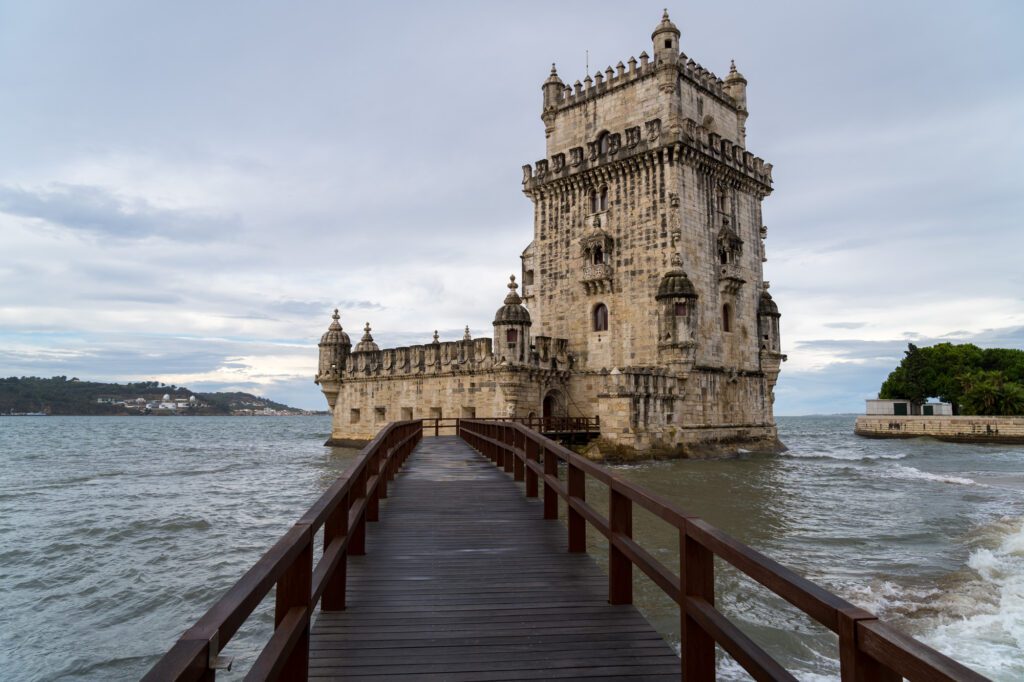
Belém used to be a separate city, but as Lisbon expanded it has swallowed it up and now it’s a district within the broader city of Lisbon.
It’s right along the river, and is home to several cool sights, including the Torre de Belém, a huge (beautiful) monastery, and, perhaps the most important, Pastéis de Belém, which is said to be the birthplace of the original pastel de nata.
Today, the entirety of Belém is a UNESCO World Heritage Site.
Here are a few places that we think are worth your time.
Igreja de Santa Maria de Belém: There are two pieces here – the church and the Mosteiro dos Jerónimos next door is also worth a visit (mostly for the incredible cloister and other architectural details). I went into the cloister of the Mosteiro for the first time on my latest trip, and it was 100% worth the cost for the architecture. I would buy tickets online in advance to avoid lines at the ticket office, which can get long.
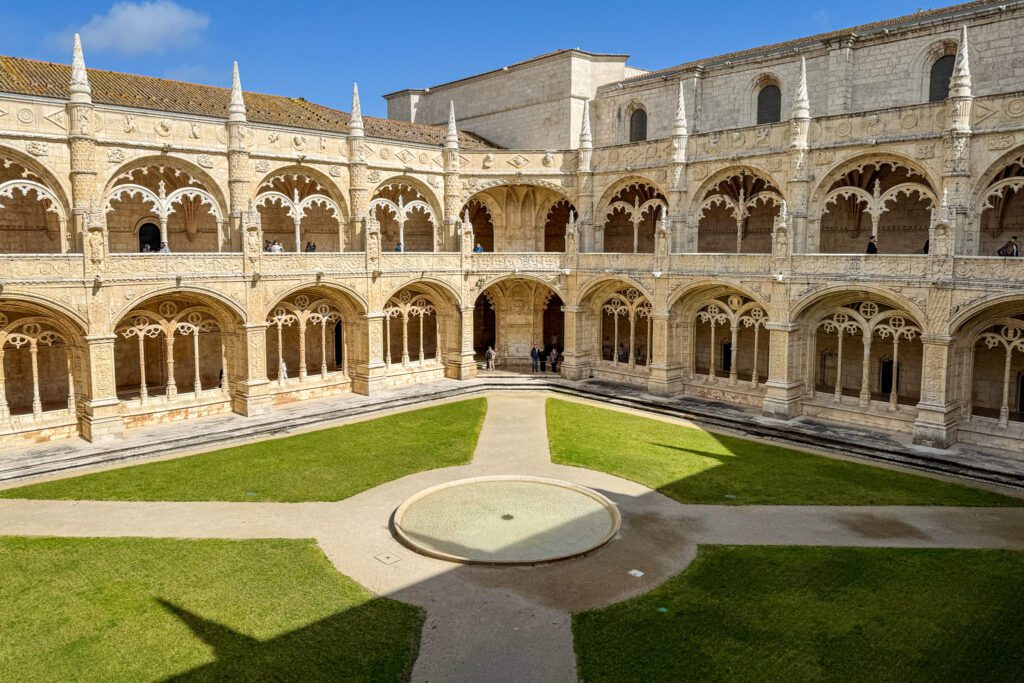
Pastéis de Belém: As we mentioned above, this is where the monks got their big idea to take the over-abundance of eggs and sugar and convert it into cash (through their pastel de nata recipe). It’s a must-stop if you’re looking to compare the various proprietors around Lisbon since it is (allegedly) the original.
Padrão dos Descobrimentos: A riverside monument that celebrates Portugal’s maritime heritage with some of the most famous explorers in world history depicted here. No need to go inside.
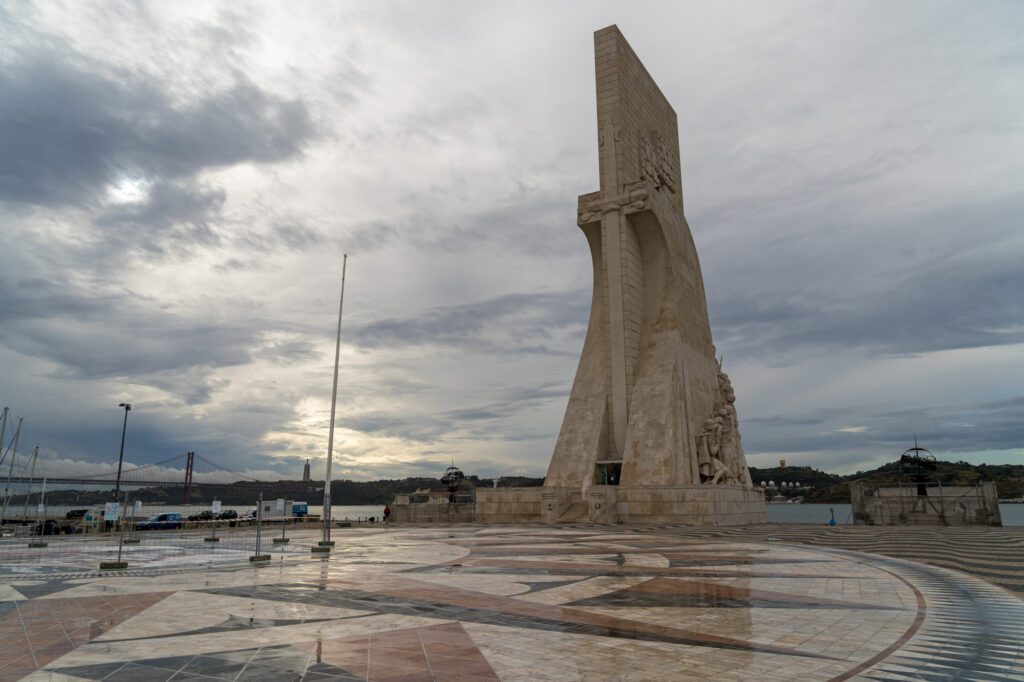
Torre de Belém: The crown jewel of Belém, this tower has served many purposes over the years, from prison to guard tower. Don’t go up into the tower. We just saved you 6 Euros a person. Lines are long, and the view from the top isn’t really worth the money or the time it’ll take you to get there. It is, however, worth admiring from the outside.
On your way to or from Belém from the city center, it’s worth stopping at LX Factory, a converted industrial area that has been taken over by a nice variety of restaurants and hip shops.
Is it “authentic”? Not necessarily. Is it a nice place to spend an hour checking out the shops and grabbing a drink or a coffee? We think so.
Planning Your Day Trip to Sintra
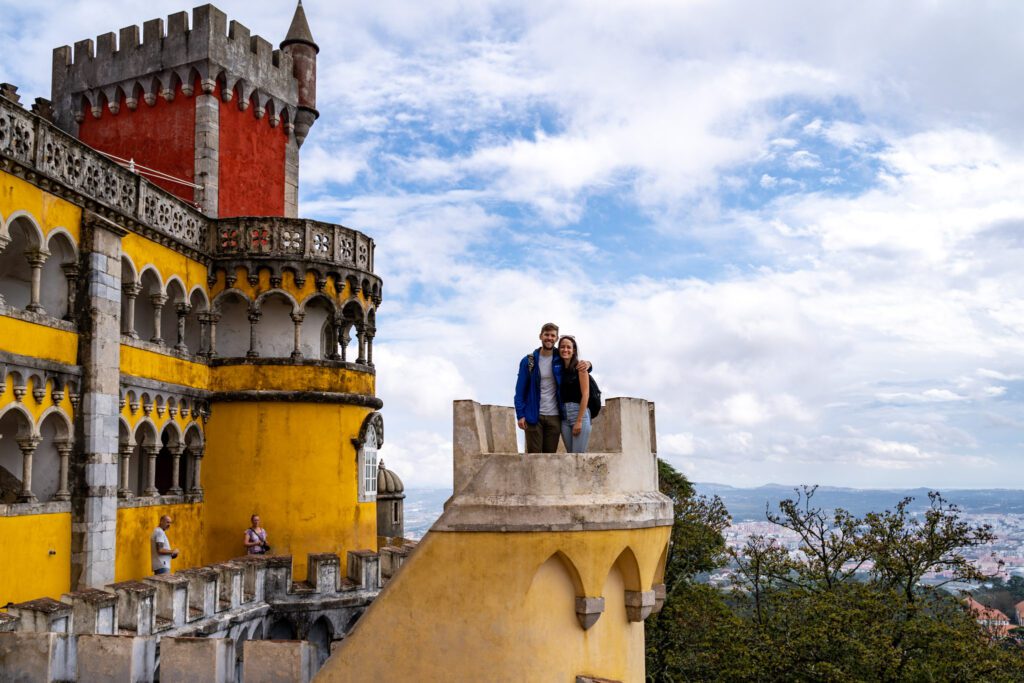
Sintra is the most popular day trip from Lisbon, and for good reason (we think).
It’s easily accessible by train from the city, it offers something a little different from Lisbon, and it has enough to do to fill anywhere between a half day and a full day, depending on what you’re looking for.
Sintra is a quick and easy 45 minute train ride northwest of Lisbon, and refers to a relatively large area that includes both a city and the hill that looms above it.
On top of that hill was, originally, a religious site that was meant as a quiet place to get away from the hustle and bustle of Lisbon and contemplate life.
But then, after the earthquake in 1755, the monastery atop the hill suffered significant damage, and that era ended.
That’s when the king consort came in and snatched up the land and decided to build Pena Palace, which was essentially built as a summer home for him and his friends and family (the unique microclimate of Sintra, where it’s foggy and cool in the morning, means it’s much more pleasant than Lisbon in the summer).
However, it’s worth noting that Pena Palace is NOT the only sight worth seeing in Sintra, and we actually wouldn’t even recommend going inside the palace (spend your time on the wonderful gardens and grounds instead).
We’d do the grounds of Pena Palace, the Castelo do Mouros (which has magnificent views out towards the coast), and maybe Quinta da Regaleira (depending on how much appetite you have for different sights).
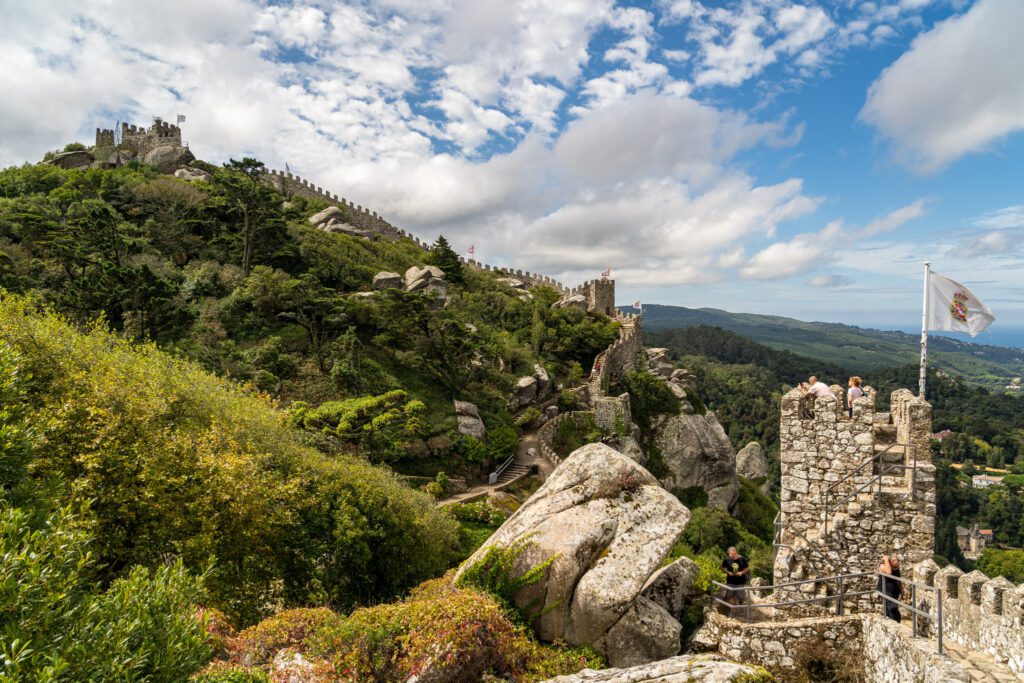
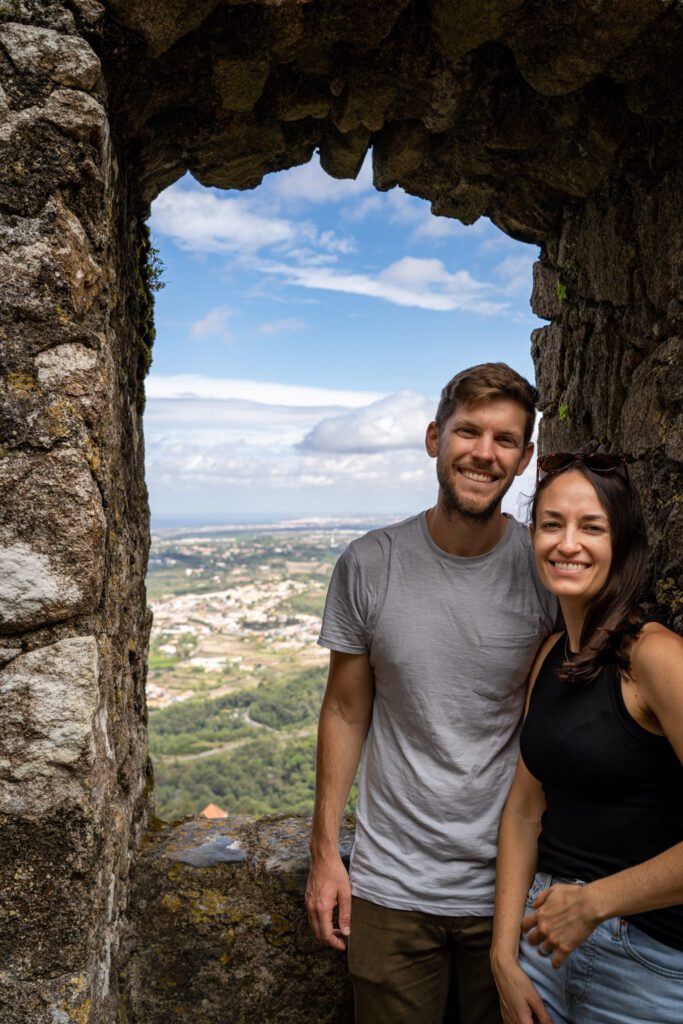

If you do want to do the third site, we’d do the first two in the morning, then have lunch and try Travesseiro, the famous pillow pastry (at the famous Piriquita in town) before heading out to Quinta da Regaleira.
One of our biggest pieces of advice for Sintra is to start your day early, and start from the top of the hill at Pena Palace and work your way down.
Take a bus, tuk tuk, or taxi from the train station to the top of the hill, and you’ll have an easy walk down the hill back to town to finish your day and catch the train home.
Rather than cover all of that information here in this already long guide, we’re going to direct you to our guide to planning a day trip to Sintra, which has everything you need to know – including logistics, what to see, and how to plan your itinerary.
Where to Stay in Lisbon
Lisbon is a bigger city than Porto, so where you choose to stay is going to have more of an impact on your trip here.
When you’re thinking about central Lisbon – the part of the city that you’ll likely want to stay in (especially if it’s your first time), you can basically think about it as two hills and the valley between them, with the river (the Tagus) acting as a natural border for the city center.
The valley is called “Baixa” and is the most modern part of the city because it’s the place most affected by the fire that decimated Lisbon in the 18th Century (and stalled Portugal’s development).
Similar to other big European capitals (London is a great example), that fire allowed for more modern urban planning, and Baixa is the most gridded section of Lisbon for that reason.
It’s also the most well-connected with buses, trams, and an underground metro running through it.
It’s probably the best place to stay if you have mobility restrictions since it’s flat, but you’ll still have to climb a hill to go basically anywhere in Lisbon.
The hill on the north side of Baixa is where you’ll find Alfama, the most charming part of the city. It’s also the least accessible in terms of public transportation (except for the popular tram 28), so we’d plan on visiting but probably wouldn’t stay there.
The hill rising to the south of Baixa is where you’ll find Chiado (and Bairro Alto at the very top of the hill), and is our top recommendation because you’ll be right in the middle of the action.
Our top recommendation is up the hill in a very central location, Chiado, and it’s the best location in Lisbon (we think) because it’s a 15 minute walk to basically everything, and the trams run right through the center of the neighborhood.
Casa do Barao is our number one recommendation here, and we have it saved for our next trip to Lisbon.
It’s a little bit of a splurge for sure, but the property is gorgeous and the spacious rooms with terraces overlooking the pool are what dreams are made of.
A few years ago, my mom went to Portugal (including Lisbon) and, unsurprisingly, used a lot of our guides to help her plan her trip. I ended up helping her pick a place to stay – an aparthotel called 54 São Paulo – which she absolutely loved.
Click here to find the perfect place to stay in Chiado
If you want to stay in the lowlands, which is convenient for connecting with public transportation, Baixa is where you want to be.
It’s a grid layout – a much more modern approach to city planning than the rest of the city – and it’s going to be a little less charming than other parts of Lisbon.
Look at the area around Rossio Square, which puts you in an excellent location for your day trip to Sintra, and is our favorite part of this neighborhood.
There are two great midrange hotels here – My Story Hotel Figueira and My Story Hotel Rossio – which would be a solid option.
I (Matt) stayed at the Visionaire Apartments on Praça da Figueira (which is right next to Rossio Square) and loved it.
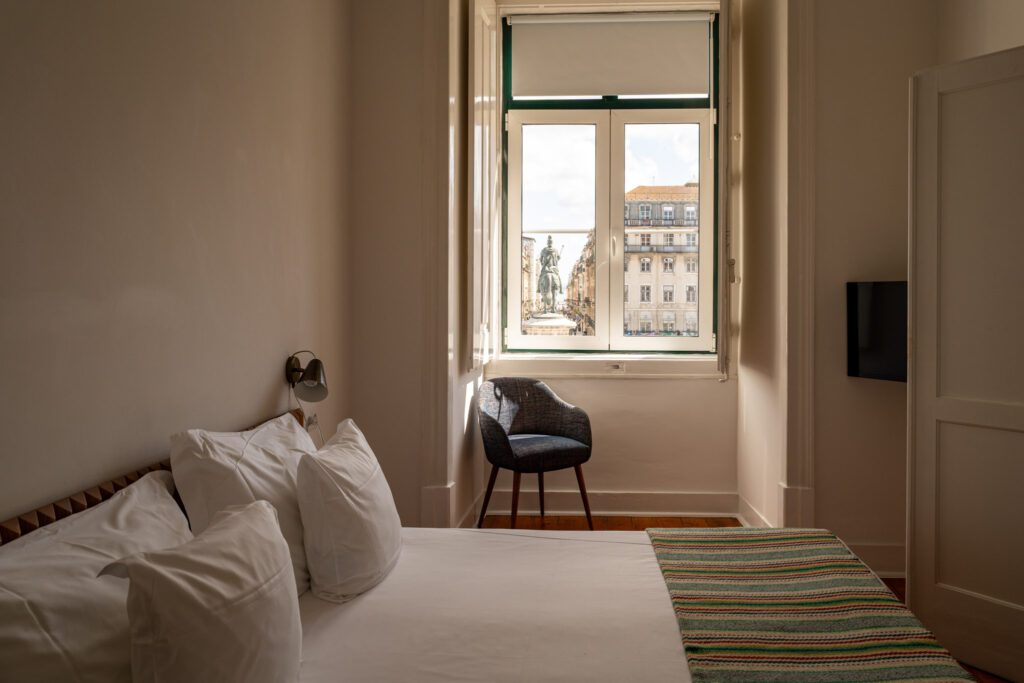
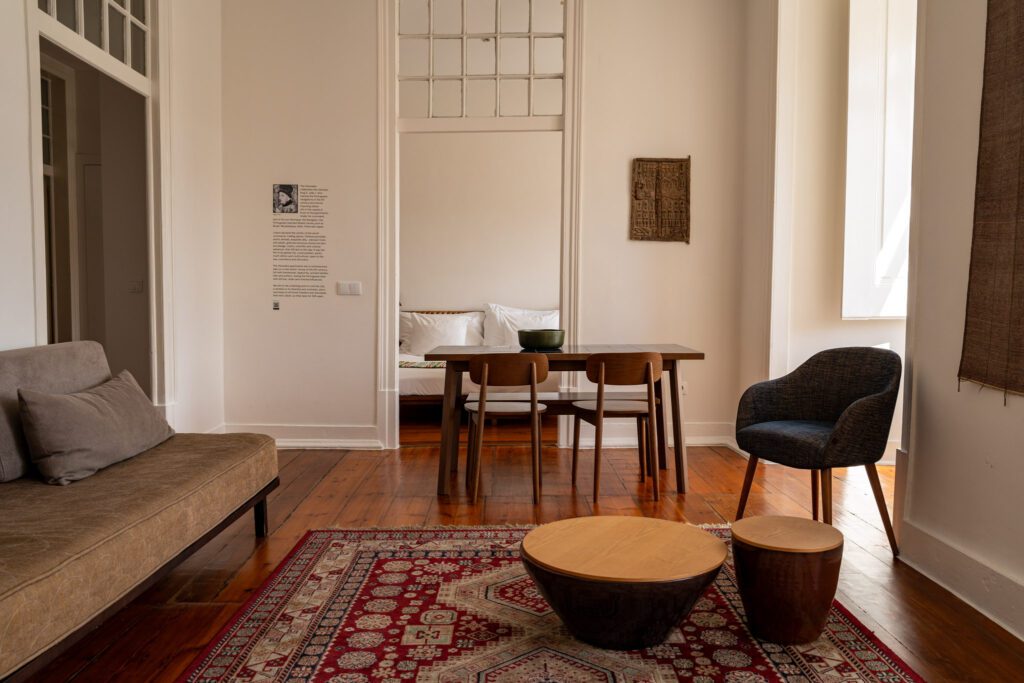
It’s super convenient for going just about anywhere in Lisbon, and the apartments themselves were in great shape with nice views out over the square below (though it was significantly less loud than I expected).
Click here to find the perfect place to stay in Baixa
Again, we have put together an entire (very detailed) guide dedicated to finding the perfect place to stay in Lisbon. Read that for far more detail than we’re including in this section.
Days 7-10: The Algarve
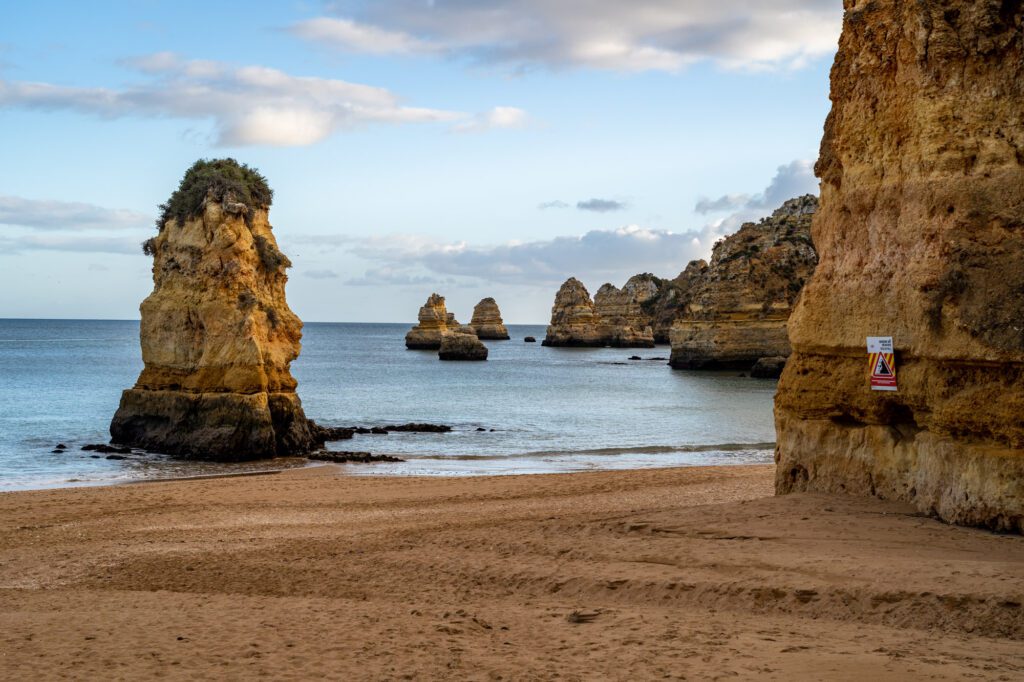
The Algarve refers to the region that covers most of the southern coast of Portugal along the Mediterranean. If you’re into beaches, especially the wide sandy variety, this is the place for you.
Particularly the western Algarve, which we’d call everything from Sagres (the southwestern tip of continental Europe) to Faro (the main transport hub of the Algarve, and where you’ll take the train and pick up your rental car).
It’s worth noting that we’re not huge beach people ourselves, but we did spend a week exploring the Algarve a few years ago (in late November, so it was relatively quiet), and it’s hard to argue with the natural beauty here.
However, it’s also worth noting that parts of the Algarve feel oddly… British? And it’s because there are a ton of British retirees here.
So many, in fact, that there are British pubs and even British grocery stores littered around the small towns on the Algarve.
We think that the Algarve is a worthy inclusion on your itinerary despite the slightly wonky logistics because of the contrast between this part of Portugal and the cities further north.
Down here, it’s more Mediterranean, with incredible fresh fish and seafood, warm weather (too warm in the summer for us), and a gorgeous coastline full of golden sand beaches and coves of turquoise water.
It’s the perfect place to spend the last few days of your itinerary soaking up the sun and relaxing on the beach before returning home.
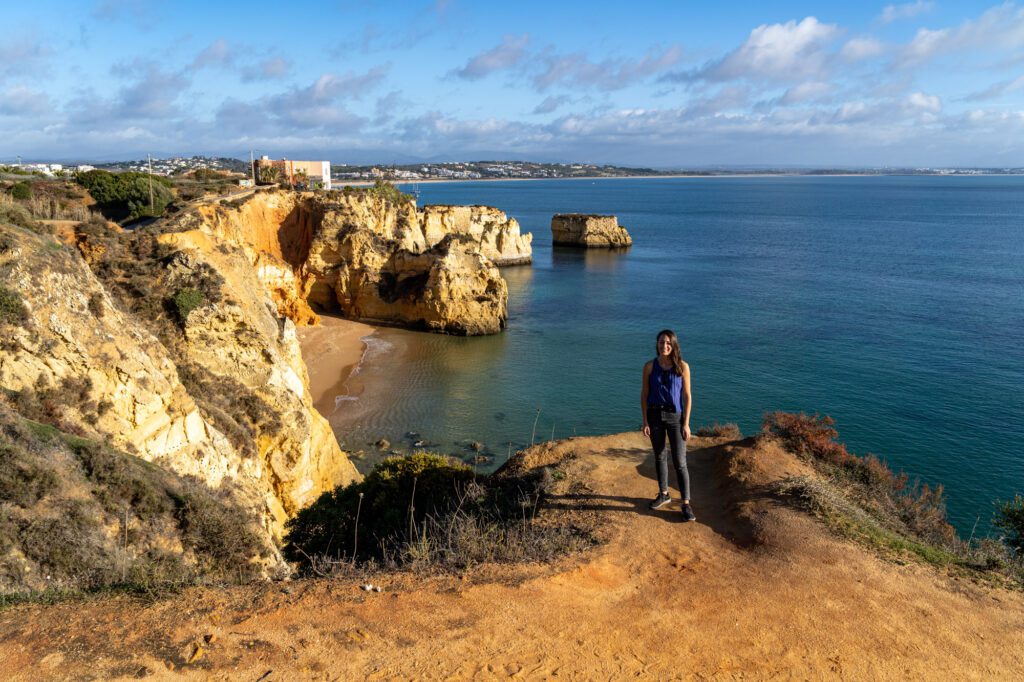
Getting to the Algarve
There are three options for getting to the Algarve if you’re coming from Lisbon. We used Omio to compare (and usually, book) our trains and buses in Spain and Portugal.
It’s a better user experience (we occasionally ran into issues with our foreign credit cards being declined by the official train websites) and it’ll just cost you a small service fee (usually 1 Euro per ticket).
First is the train. We love traveling by train in Europe, and there are intercity trains (those are the fast ones!) that will get you from Lisbon to Faro in 3 hours.
From there, you’ll have to connect with a regional train to get to places on the Algarve like Lagos or Carvoeiro (spoiler: those are two places we’d recommend staying on the Algarve).
Book your train tickets as far in advance as possible for lower prices.
Second is the bus – we’d opt for FLIXBUS. The bus is slightly less comfortable, we think, but usually cheaper (especially if you’re booking close to the date of travel, when Intercity trains become more expensive).
There are also more direct options to more places on the Algarve (Lagos, in particular), versus the train to Faro and then connecting with a regional train from there.
The bus is going to take about 3.5 hours, and cost somewhere around 6-10 Euros.
Third is renting a car in Lisbon and driving, which takes about three hours or so. This is a particularly good option if you’re flying out of Lisbon to get back home.
If that’s the case, this is actually our top recommendation because it’ll make getting back to catch your flight a little more simple, and you won’t have to pay a one-way fee for dropping off the car in a different place than where you picked it up.
Whichever way you choose, we’d opt for an early departure from Lisbon to get you to the Algarve for the afternoon.
Click here to compare your different options on Omio.
Do You Need a Car on the Algarve?
After traveling by train and bus for part of our trip to the Algarve, and then renting a car for the second part, we have a strong perspective that the best way to enjoy the Algarve is by renting a car.
Sure, there is a regional train network that connects the major towns on the Algarve, but oftentimes the best beaches are going to be a bit outside of town, and a car makes it easier to get there.
Having a car will also give you more flexibility, since trains aren’t that plentiful (they only come a few times a day) and it’s hard to figure out exactly when local and regional buses come (or if they come at all).
We rented a car twice during our three month European adventure, once in Sicily, once on the Algarve.
Both times we used AutoEurope to compare prices with different rental companies and find the best rates, and booked a car through Europcar, which was a pleasant experience both times. We’d recommend both.
Depending on prices and timing, you could either train to Faro and pick up the car there, or pick up the car in Lisbon and drive down to the Algarve and back (which will make getting back to Lisbon to catch a flight a bit easier, we think).
What to Do on the Algarve
You have three days on the Algarve, and we have a strong perspective on what you should do with those days based on our own experiences.
Explore Lagos and Around
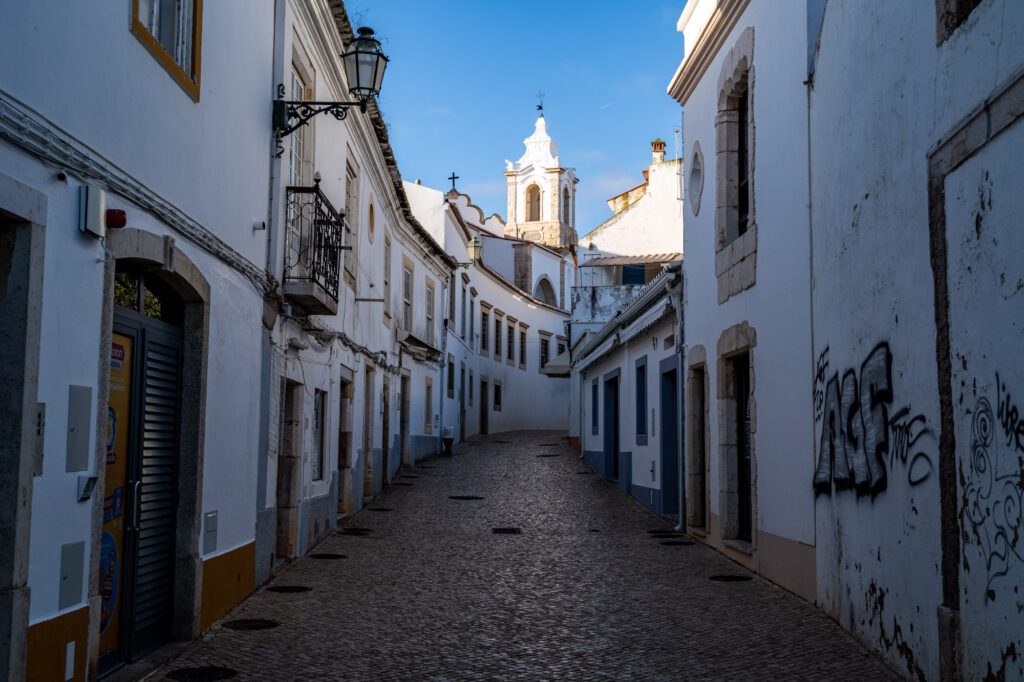
We think this should be your first day. Spend the day settling in and exploring the area around Lagos.
There are three beaches in particular that we think are well worth your time.
The first, Praia dos Estudantes, is one of the Algarve’s most famous beaches thanks to the Roman bridge that is visible from the beach.
Next, stop by Praia do Pinhão, where you can pick up a coastal route up on the bluffs that takes you to the third beach on your tour-de-Lagos-beaches.
The last beach, Praia da Dona Ana, is also one of the most-visited beaches in the entire region.
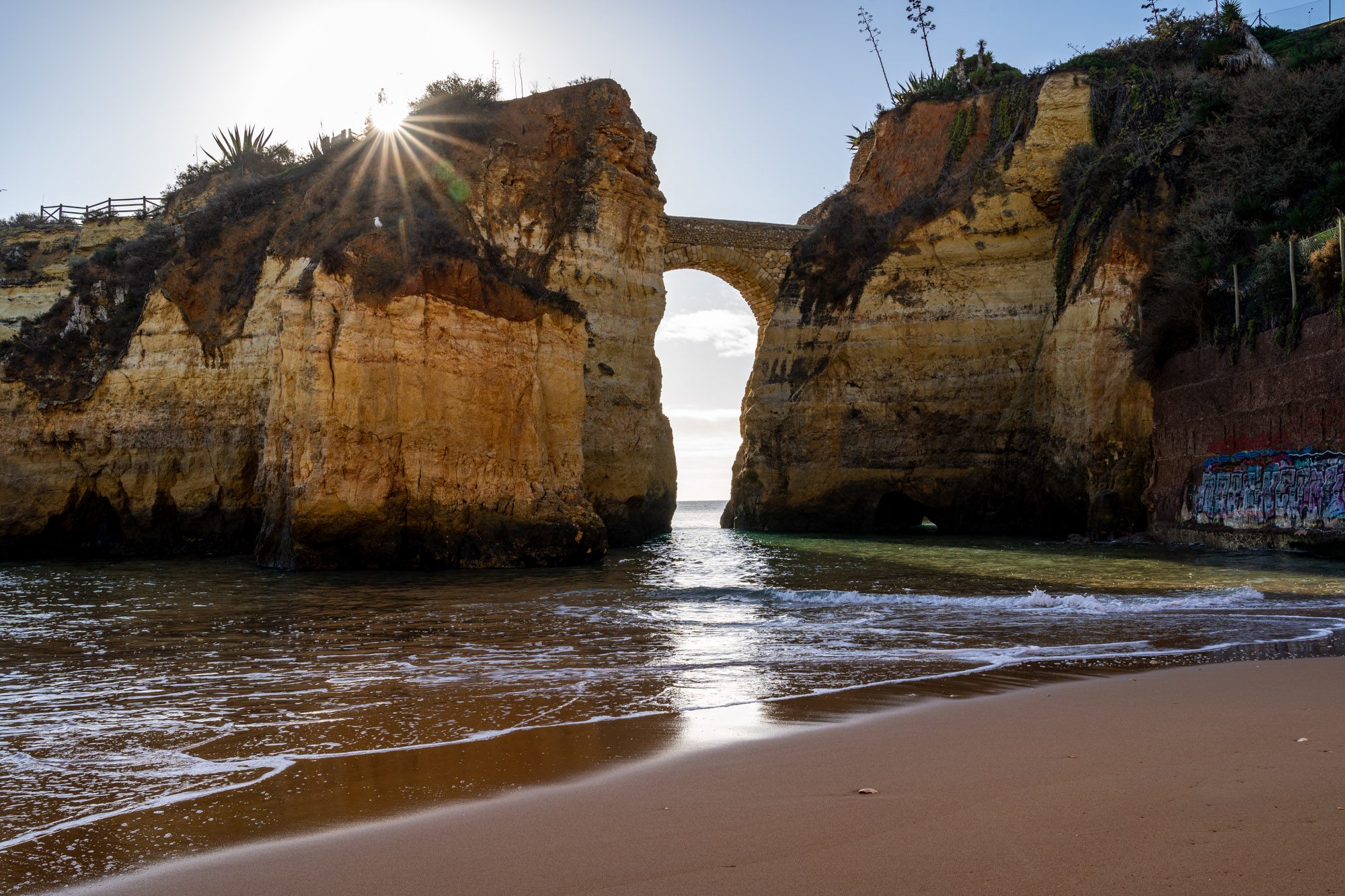
It’s a little cove, accessible from both ends, and the best views of the beach are from the bluffs on the eastern side (which is where you’ll find yourself if you follow the coastal trail).
All three beaches would be a good spot to relax in the sun for a few hours. Make sure to bring sunscreen and plenty of water.
You can walk to all of them, doing one big loop back to the center of Lagos (something like this).
For seafood that’s about as fresh as it can be, head out to Restaurante Chico Zé for lunch, which is a 10 minute drive north of the center of Lagos.
It’s a family run, lunch-only establishment where there is almost always a line out the door during the high season (and sometimes during shoulder seasons). Don’t miss the grilled sardines, served with potatoes.
An alternative closer to town would be Tasca Da Lota, which is within walking distance of the city center near the train station. It’s cash only.
For sunset, drive out to Ponta da Piedade, which is a unique rock formation surrounded by sheer cliffs.
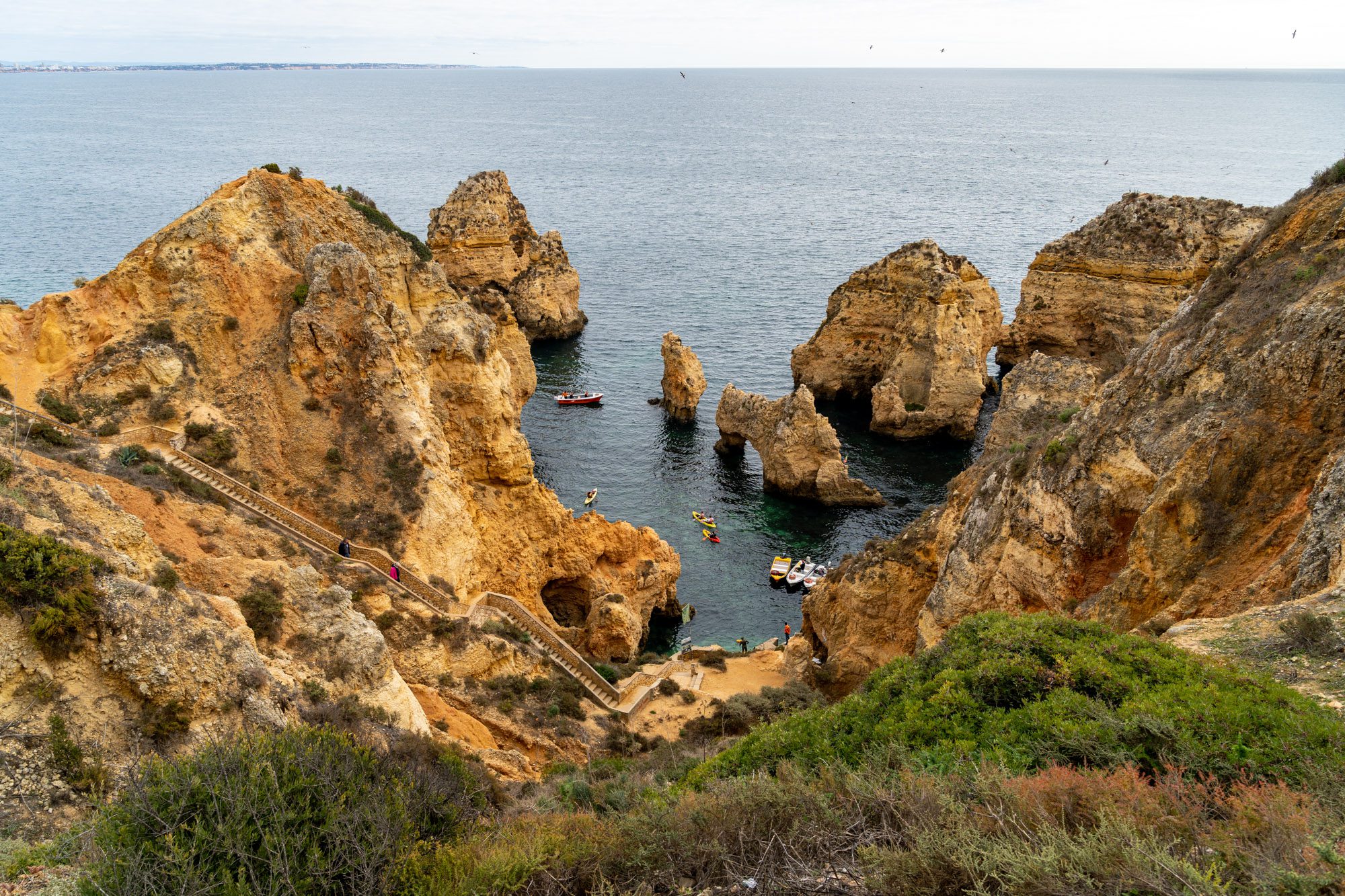
It’s a spot that most of the boat tours leaving from Lagos stop at because there’s a series of cool sea caves and hidden grottos.
On foot, you can walk down the long set of stairs to get to the base of the cliffs – just remember that you’ll have to climb back up.
Once you’ve done that, it’s also worth finding the trail that heads west from the parking lot and walking along the boardwalks for more amazing coastal views.
On the way, stop by Praia do Camilo, a small, hidden beach accessible only by climbing down a long set of steep stairs (and, again, climbing back up when you’re done, of course).
Hike the Seven Hanging Valleys Trail
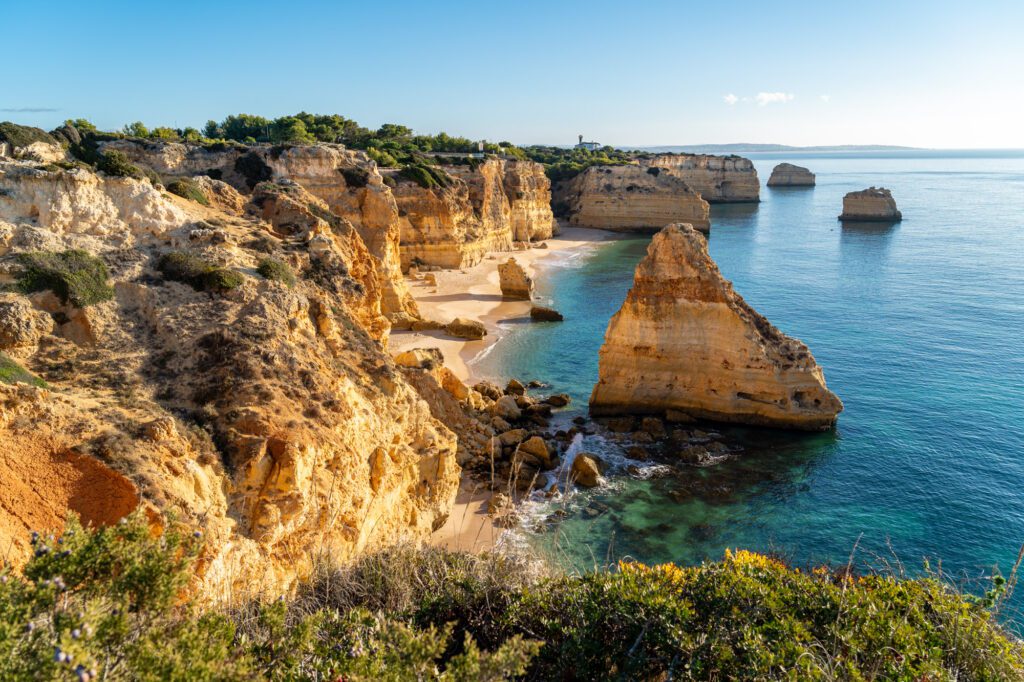
We’d spend the better part of one of your mornings tackling what we think is the best hike on the Algarve – the Seven Hanging Valleys Trail.
This hike, best done from east to west starting from Praia da Marinha to Praia do Vale de Centeanes, was one of our favorite experiences in Portugal.
And we’re from coastal California, which we learned is very similar to the Algarve in terms of scenery, flora, and fauna.
The point is, it’s a great hike, and that’s coming from two people who have done countless hikes with similar views and scenery.
First, an overview of the full out-and-back hike.
- Length: 7 miles / 11.4 km
- Elevation Gain: 1,200 ft. / 365 meters
- Season: Year round (more on this below)
- Trail Type: Out and Back (we have ideas on alternate routes below)
- Difficulty: Easy / Moderate
- Trailhead Location: Either Praia da Marinha or Praia do Vale de Centeanes
- Dog Friendly: Yes!
If that sounds like too much for you, you have a few options in terms of shortening the hike.
- Option 1: The Full Hike, Round Trip – 7 miles / 1,200 feet of elevation gain (11.4 km / 365 m). Hike the entire trail out-and-back from Praia da Marinha to Praia do Vale de Centeanes, and then back the way you came.
- Option 2: The Full Hike, One Way – 3.5 miles / 600 feet of elevation gain (6 km / 180 m). Do the entire hike, but only one way. This requires using either taxis, Uber, or hitching a ride to get back to your car at the first trailhead (or finding a way to get there without a car).
- Option 3: Partial Hike, Out and Back –3.3 miles / 600 feet of elevation gain (5.6 km / 180 m). Hike the section between Praia da Marinha and Praia do Carvalho, which in our opinion is the best part of the trail. You can continue on to the nice lighthouse – Farol de Alfanzina, for an additional 2 miles (3.2 km) added to your round-trip distance.
For more details, including which direction to go, where to park, what time of day to hike, and a detailed trail report, head over to our Seven Hanging Valleys Trail Guide.
Finish your day at the ending point for the trail you hiked earlier in the day – Praia do Vale de Centeanes – which is a pretty spectacular place to watch the sunset.
You can either bring a blanket and set up shop on the beach, or head up onto the bluffs to the east of the beach, where there’s a point that juts out into the sea and has some benches overlooking the spectacular coastal landscape.
Sagres and the Western Algarve
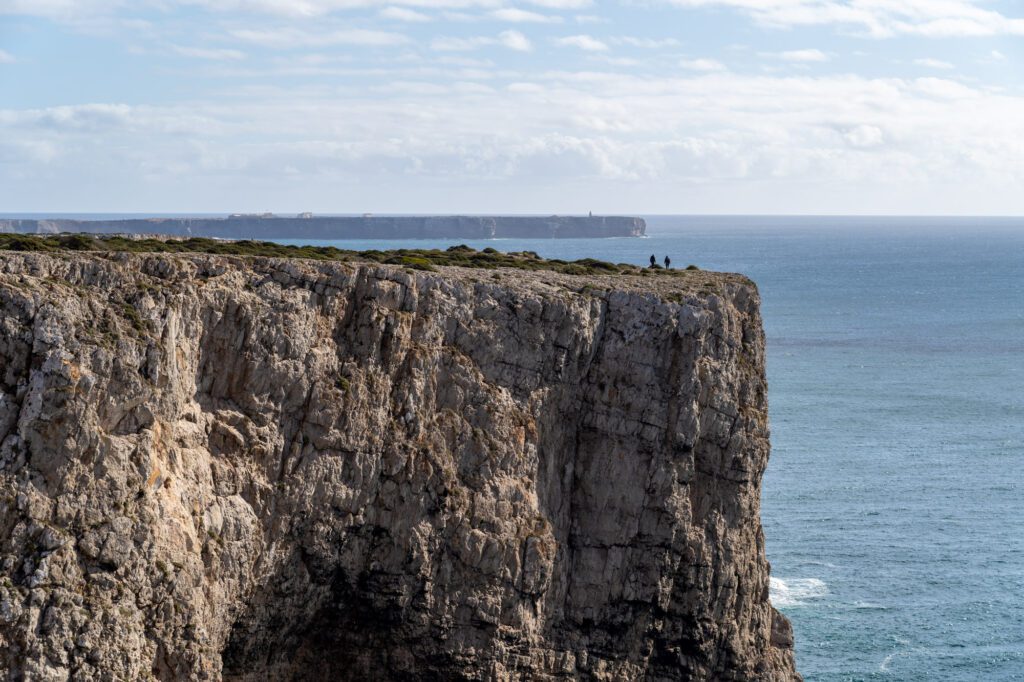
Head west towards the Atlantic Ocean, where you’ll find a dramatic coastline that looks a little bit different than the one you’ve explored so far.
Think towering limestone cliffs and dramatic drop offs with the churning sea below.
This part of the Algarve, which is much quieter than the area around Lagos and to the east, reminds us a lot of Point Reyes National Seashore, which is a short drive from where Alysha grew up in Northern California.
Start by driving all the way out to Farol do Cabo de São Vicente, the southwestern-most point in Europe, and making your way back east towards Lagos.
- Praia do Beliche (here on Google Maps) was our favorite beach in the area, and the steps leading down to it are super steep (which is saying something in Europe, land of the unnecessarily steep steps).
- The town of Sagres is a little sleepy, but it’s worth heading out to the Fortaleza de Sagres, which you’ll have to pay a few Euros to access, but the views from the point are worth it. It is going to be windy when you’re there – it almost always is. It’s also home to some of the best surfing in Europe if that’s something you’re into. We were there in the winter, so we took a hard pass on surfing lessons.
- Praia da Mareta (here on Google Maps) and Praia do Martinhal (here on Google Maps) are two nearby beaches we enjoyed.
After you’ve explored Sagres and the surrounding area, you can either head back to where you’re staying and do some more exploring, or head up the coast north along Portugal’s Atlantic coast to Praia da Arrifana, which is a different feeling than the Algarve.
Or you could stop by the small fishing town of Salema on your way back to Lagos.
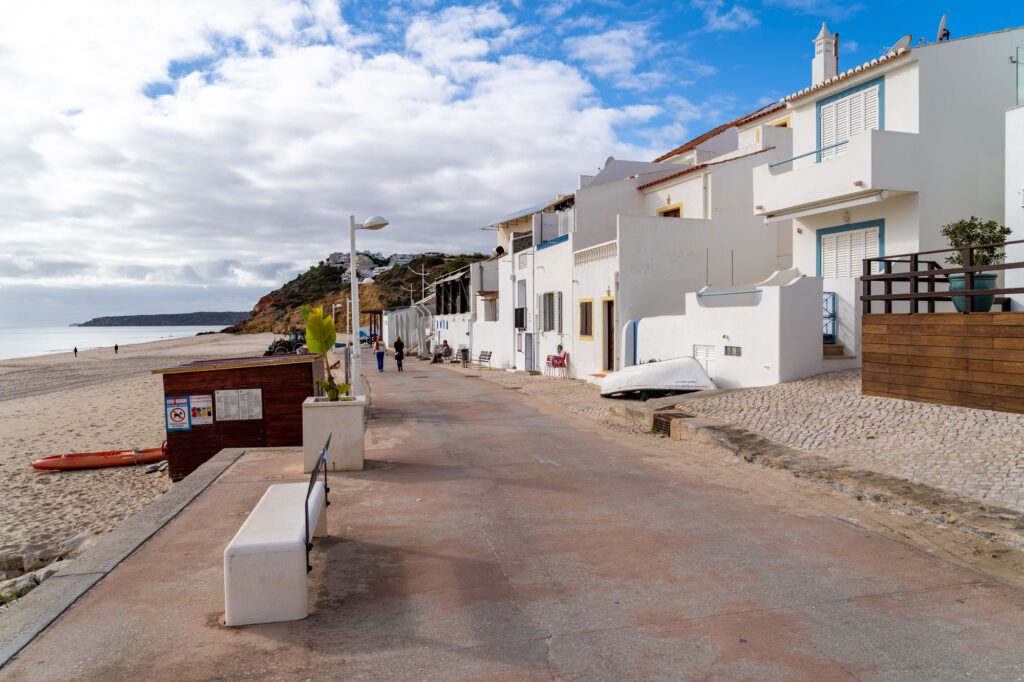
Where to Stay in the Algarve
For this amount of time on the Algarve, we’d recommend choosing one home base and exploring from there.
Keep in mind that this is the quick version. We have an entire guide dedicated to choosing exactly where to stay in the Algarve, so you should head over there if you want the details.
For the sake of convenience, we also think that place should be relatively central to give you the best access to both the eastern Algarve and its pristine white sand beaches, and the rocky, cliff-y (is that a word?) coastline of the western Algarve.
We stayed in two separate places in the Algarve, and would recommend them both.
Those two places are Lagos and Carvoeiro, and anywhere in between those two, which are a 35 minute drive apart, would be a perfect place to stay.
Lagos is more of a city, with a charming old town and plenty of bars, restaurants, and other amenities that you might be interested in.
If you’re looking to stay in the middle of a bustling city with lots of restaurant options and bars that are open until the early hours of the morning, Lagos is for you.
In Lagos, we stayed at the Salty Lodge, which is smack dab in the middle of the old town.
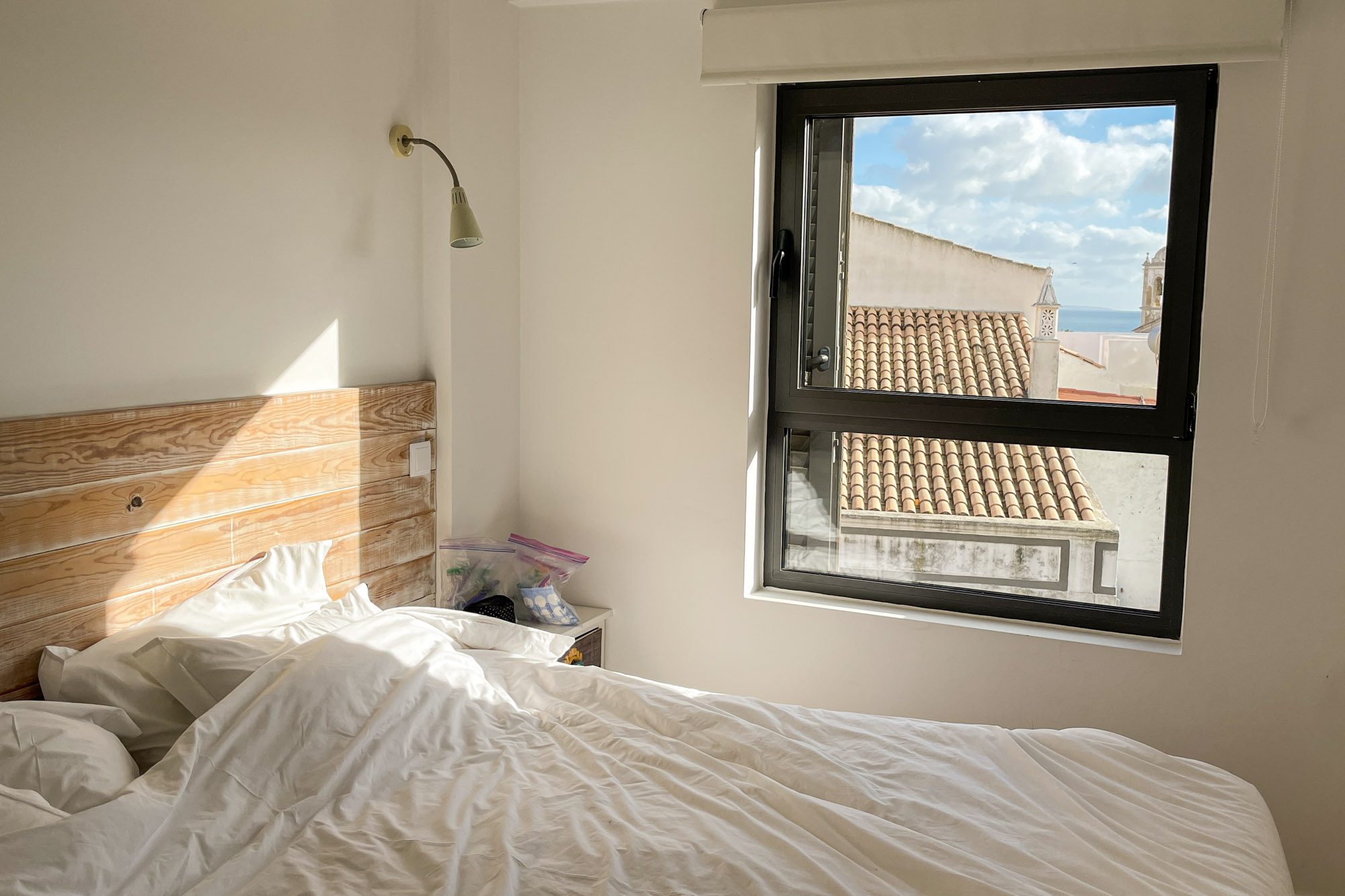
We really enjoyed this place, and our room had a pretty spectacular view towards the ocean. If your room doesn’t, they also have a rooftop terrace with this view.
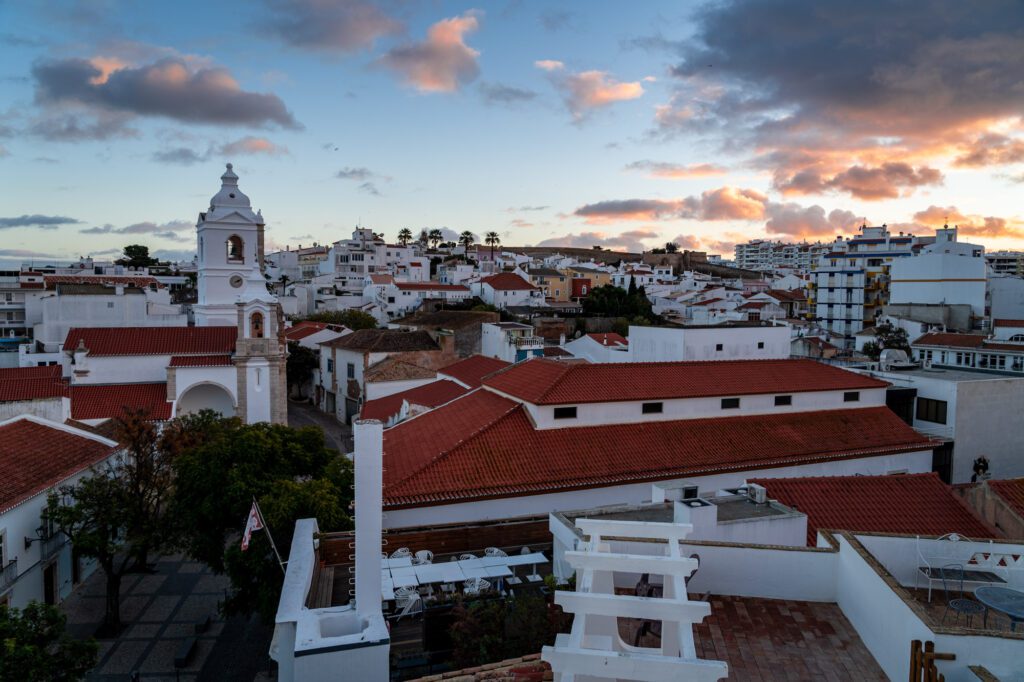
Rooms at the Salty Lodge are apartment-style, complete with stovetops and ovens for cooking.
Though you’ll be within walking distance of about 25 different restaurants, if you’d rather do not cook on your trip to Portugal.
Carvoiero – the other place we stayed – has a more relaxed vibe.
Sure, there’s a little area near the main beach that has a nice stretch of bars and restaurants, but the draw here is the unparalleled access to beautiful beaches and the laid back nature of the town.
If you’re looking for a relaxing, quiet place to stay, we’d recommend Carvoeiro.
In Carvoeiro, we stayed at Hello Villas, which turned out to be among the nicest places we stayed on our entire Portugal trip.
They’re spacious, quiet, and have everything you need to cook meals at home.
Plus, they’re walking distance to town, though there’s a rather steep hill in between.
Dive deeper into the Algarve with our other Algarve travel guides:
- A Complete Guide to Planning an Algarve Road Trip (3-7 Days)
- How to Hike the Seven Hanging Valleys Trail: Complete Trail Guide
- Where to Stay on the Algarve: 5 Charming Towns to Use as a Home Base
What to Add with More Time in Portugal
If you’re lucky enough to find yourself with more than 10 days when you’re visiting Portugal, here are a few things that we’d add to your itinerary, along with how much time we’d allocate to each.
Obviously, you could add a day or two to each of the places already on the itinerary, and that would honestly be our first choice over the options below.
The Porto to Lisbon Corridor (+2-5 Days)
There is a ton to do and see between Lisbon and Porto, and this corridor is the first thing we’d add to your itinerary should you find yourself with a couple of extra days.
The biggest thing to think about going into planning this leg would be whether or not you want to rent a car.
Unfortunately, while it is true that Lisbon, Porto, and Faro are all fairly well connected by train, that network starts to fall apart as you get further out towards the coast.
There are buses connecting cities like Nazaré, Óbidos, and Peniche (through Rede), but they will take a LONG time compared to driving (we’re talking 60 mins on the bus versus 20 minutes driving), which makes it a far less appealing option if you have limited time.
Ultimately, this means that in order to make the most of your time in this part of Portugal, you really have to be willing to rent a car (similar to the Algarve).
On my latest trip to Portugal, I had planned on using the town of Óbidos as a home base between Lisbon and Porto and spending three or four days exploring that corridor (but I got sick and had to cancel that part of the trip).
To add this to the itinerary above, you can either do a one way car rental that starts in Porto and ends in Lisbon, or rent a car with a pick up and drop off in Porto and take the train from there.
Generally we recommend picking up and dropping off at airports to avoid having to drive in the city center of these big European cities, which is no fun at all.
Coimbra (+1-2 Days)
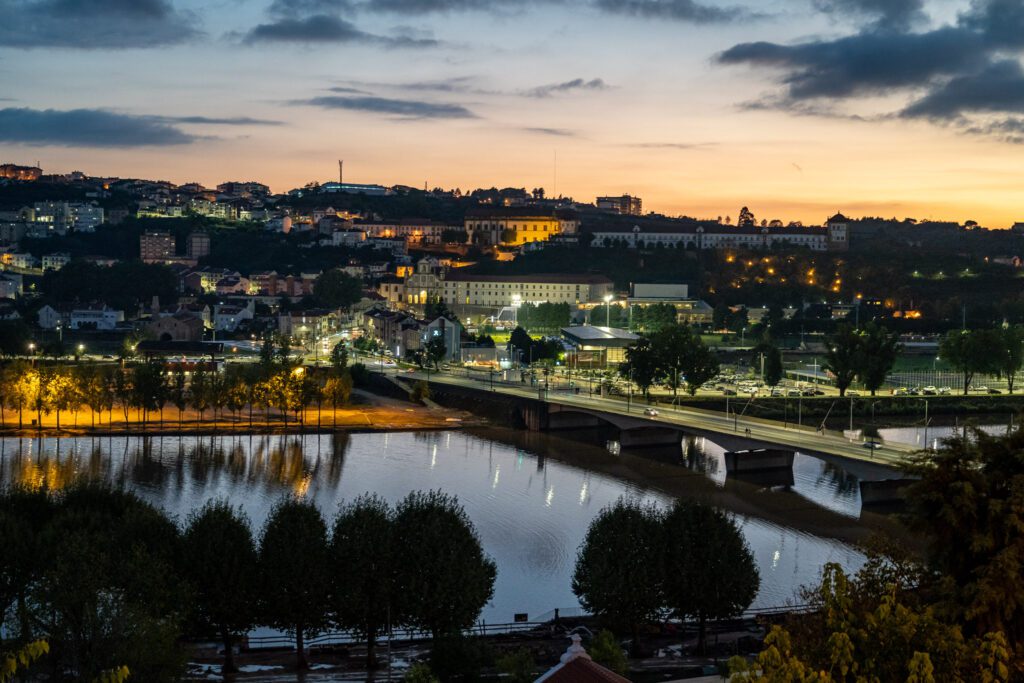
If you are not comfortable renting a car (or it’s out of the budget), then Coimbra is a great place to add between Lisbon and Porto because it is on the high speed train line that connects the two bigger cities.
We stopped in Coimbra for a couple of days a few years ago, and it’s a beautiful university town set right on the Mondego River.
The university was founded in 1290, and has been in the current location on the hilltop in Coimbra since the 16th Century.
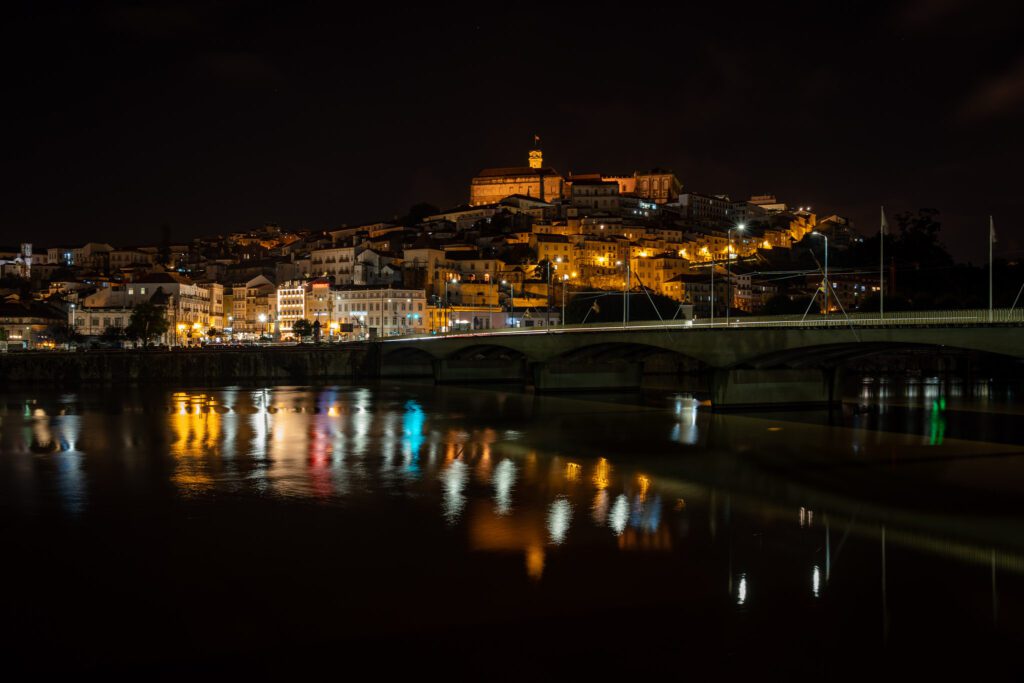
After visiting Oxford on my last trip to London, I was struck by how similar Oxford and Coimbra are. The university is the beating heart of Coimbra, and it’s well worth paying the €12.50 to go inside the library (the lower price tickets exclude the library, which is the best part).
If you’re looking for more depth and detail, you can also do a guided tour of the campus with a guide from the university – more information here.
Évora (+1-2 Days)
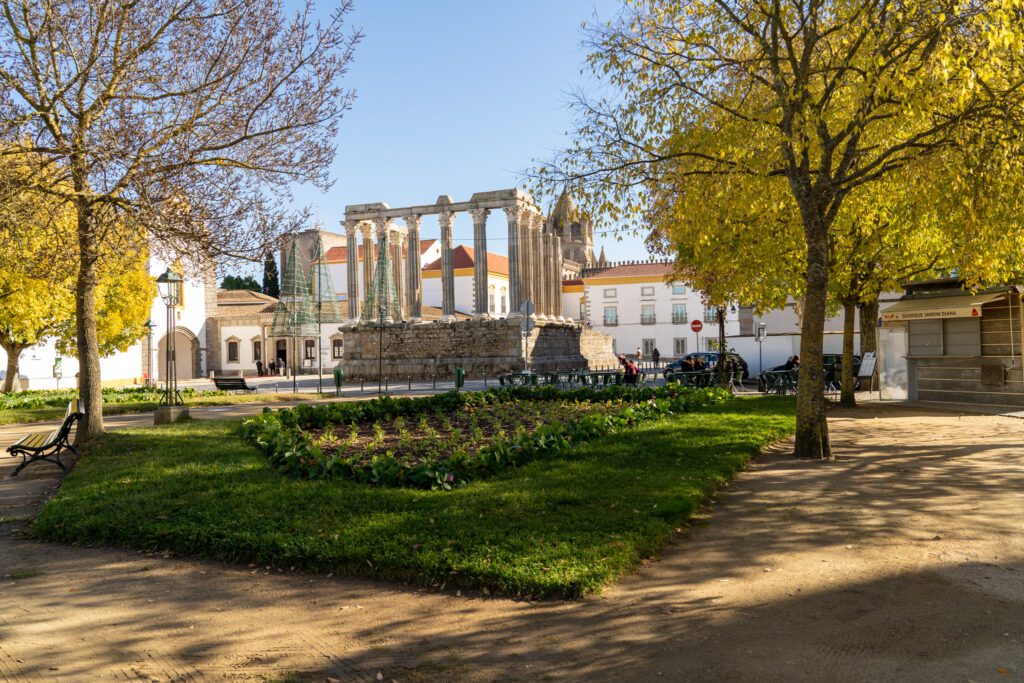
We stopped in Évora, a walled town in Portugal’s Alentejo region known for its great food and wine, for a night on our way between the Algarve and Lisbon, and we loved it. It’s a beautiful little town that has been designated a UNESCO World Heritage site.
There are Roman ruins, a nice cathedral (with roof access for a nice view), and a great public garden (with a plethora of peacocks roaming around).
We were here for about 24 hours, and that was perfect. It’s just 90 minutes from Lisbon by train, but we’d recommend staying overnight if you can.
What to Do with Less Time in Portugal
With anything less than 10 days, we’d STRONGLY recommend cutting the Algarve and focusing exclusively on the Porto to Lisbon corridor.
Not only will this cut down on travel time so that you have more time doing and less time in transit, it also means your flights in and out of Portugal will likely be easier and less complicated.
We have an entire guide dedicated to spending one week in Portugal, which focuses on that exact version of an itinerary.
If you have 8-9 days, we’d spend it in between the two cities exploring the places we mentioned above (Nazaré, Óbidos, and Peniche).
If you absolutely must see the Algarve, we’d combine it with Lisbon (rather than Porto, because Porto is FAR) and focus just on those two places.
Planning a trip to Portugal?
Here are our other Portugal travel guides to help you plan an incredible trip (even if you have to eat gluten free!).
If there’s no link below, it means we’re still working on it – long, in-depth guides take time! We’re working on it, though, we promise.
Portugal:
- Exactly How to Spend One Week in Portugal (for First Timers)
- 10 Days in Portugal: Planning the Perfect Portugal Itinerary
Lisbon
- 25 Incredible Things to Do in Lisbon: A Complete Guide
- 3 Days in Lisbon: Planning the Perfect Lisbon Itinerary
- One Day in Lisbon: The Best of Lisbon in 24 Hours
- Where to Stay in Lisbon: Our Guide to 4 Amazing Places to Stay
- Gluten Free Lisbon: A Complete Guide to Lisbon’s Best Gluten Free Restaurants
- The Best Coffee in Lisbon: 9 Amazing Lisbon Coffee Shops to Add to Your List
Porto:
- 3 Days in Porto: Planning the Perfect Porto Itinerary
- One Day in Porto: How to See the Best of Porto in a Day
- Where to Stay in Porto, Portugal: The 3 Best Places to Stay
The Algarve:

Gosh! Thank you so much for your excellent in-depth exploration of Portugal! I enjoyed reading about every spot on your itineraries. Hoping to get there in the near future. Only worry is the apparently immense amount of walking, as I have some difficulty there. Any suggestions aside from just skipping it altogether?
Hey Robin! Thanks for the kind words. Definitely don’t skip it if you’re not into walking! We happen to love walking, but you can easily modify things to get around in a different method, if you’d prefer. Lisbon and Porto have pretty good public transit systems, and you’re going to want to rent a car on the Algarve anyway. Hope that helps!
Thank you for the in-depth info. Definitely bookmarking this and will use it to plan my Spring 2023 trip!
Hey there! You’re welcome – enjoy your trip!
Matt, this is a fantastic comprehensive guide – thank you for taking the time to put it together for future Portugal travelers such as myself! Funny enough, in my research I had landed on flying into Porto and departing from Algarve as the best option for a 10 day trip, so this only further validated that!
2 questions: 1) would you book anything in advance, ie. restaurant reservations, train tickets, etc – when you absolutely know what day/time you will need those?
2) my husband isn’t as adventurous in travels as I am, so once we get to Algarve he is hoping to kind of ‘stay in one place’ and relax/beach/explore a bit. Is Lagos best for this? I’ve also heard Albufeira recommended as there is a bit of nightlife there. Would welcome your thoughts!
Hey Julie! Thanks for the kind words. Here are some thoughts on your questions.
1) I’d do restaurants a few weeks in advance if you’re REALLY set on some specific places. The long distance trains (e.g. Lisbon to Porto) are cheaper if you book them in advance, but that means less flexibility. Regional trains (e.g. Lisbon to Sintra) are the same price whether you book in advance or at the train station, so no need to book those in advance.
2) We liked Lagos, and there’s plenty to do, see, eat, and drink within walking distance of town. We stayed there and liked it. Probably the best bet in terms of places where you don’t have to move around much to have a good experience.
Hope that helps! Cheers!
What a great guide, thank you! I have Celiac disease also, and was wondering whether you found any places with great gluten-free food there. How did you find Portugal in general for the gluten-free traveler? Thanks!
Hi Matt,
My wife and I (active 65+ year olds) were thinking of going to Portugal in the Sept/Oct 2023 timeframe via a tour company but now I’m thinking of bagging that and just doing it on our own. Your website has given me a lot of invaluable info toward that end.
Question: What were the dates you went to Portugal?
Thanks & keep up the good work!
Rick
Hey Rick! Sorry we’re just getting to this. We were in Portugal in September/October and November/December.